Bosch GDB 2500 WE User Manual [en, ru, de, es, fr, it, cs, pl]
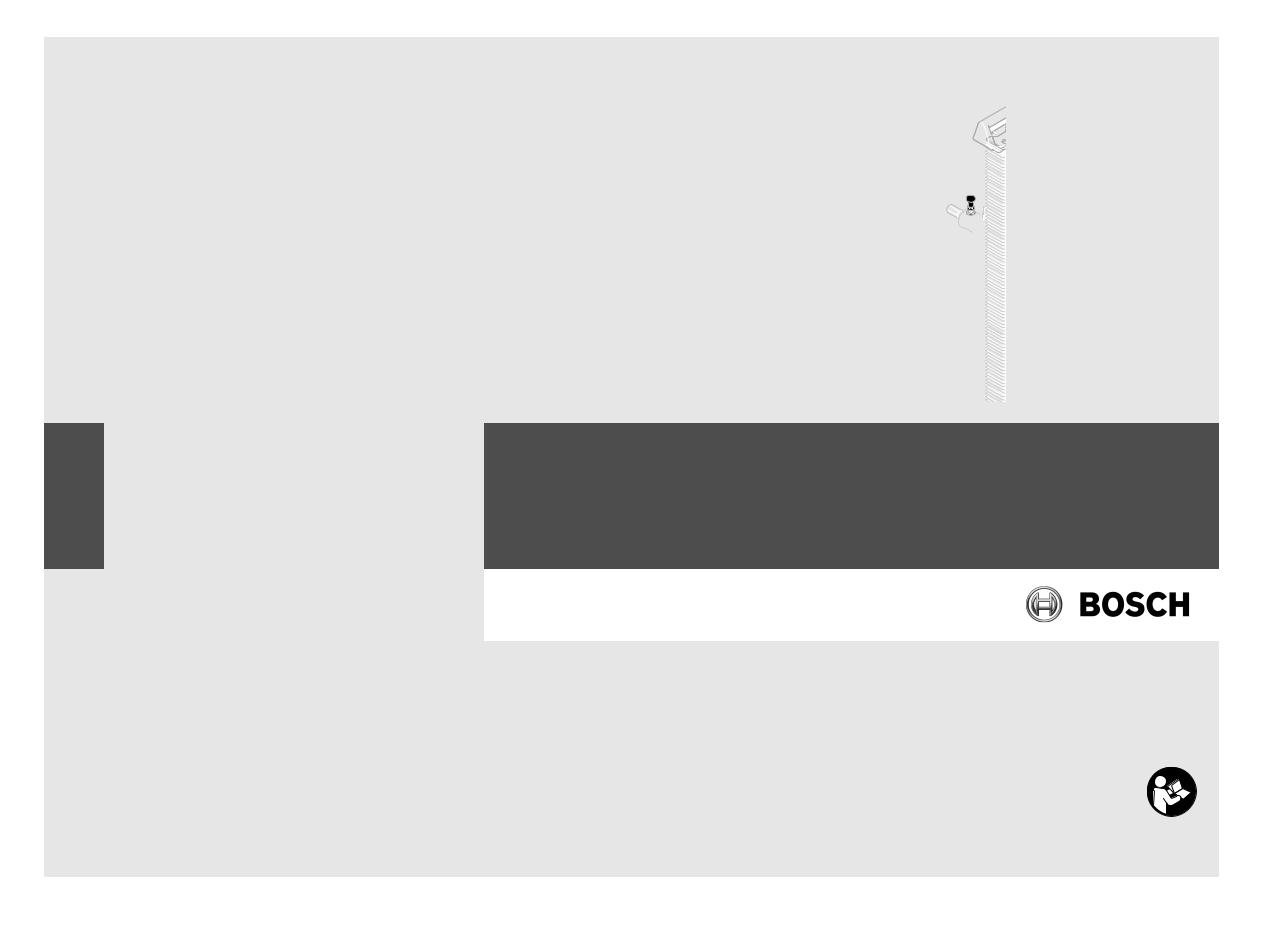
OBJ_BUCH-114-002.book Page 1 Tuesday, November 9, 2010 11:57 AM
Robert Bosch GmbH
Power Tools Division
70745 Leinfelden-Echterdingen
Germany
www.bosch-pt.com
1 609 929 W83 (2010.11) T / 271 XXX
GDB 2500 WE Professional
de |
Originalbetriebsanleitung |
pl |
Instrukcja oryginalna |
en |
Original instructions |
cs |
Původní návod k používání |
fr |
Notice originale |
sk |
Pôvodný návod na použitie |
es |
Manual original |
hu |
Eredeti használati utasítás |
pt |
Manual original |
ru |
Оригинальное руководство по |
it |
Istruzioni originali |
|
эксплуатации |
nl |
Oorspronkelijke |
uk |
Оригінальна інструкція з |
|
gebruiksaanwijzing |
|
експлуатації |
da |
Original brugsanvisning |
ro |
Instrucţiuni originale |
sv |
Bruksanvisning i original |
bg |
Оригинална инструкция |
no |
Original driftsinstruks |
sr |
Originalno uputstvo za rad |
fi |
Alkuperäiset ohjeet |
sl |
Izvirna navodila |
el |
Πρωτότυπο οδηγιών χρήσης |
hr |
Originalne upute za rad |
tr |
Orijinal işletme talimat |
et |
Algupärane kasutusjuhend |
lv Instrukcijas oriģinālvalodā lt Originali instrukcija
cn tw ko
th
id Petunjuk-Petunjuk untuk
Penggunaan Orisinal
vi BΩng hõëng dÿn nguy›n bΩn
ar |
ΔϴϠλϷ ϞϴϐθΘϟ ΕΎϤϴϠόΗ |
fa |
̶Ϡλ έΎ̯ ίήσ ̵ΎϤϨϫέ |
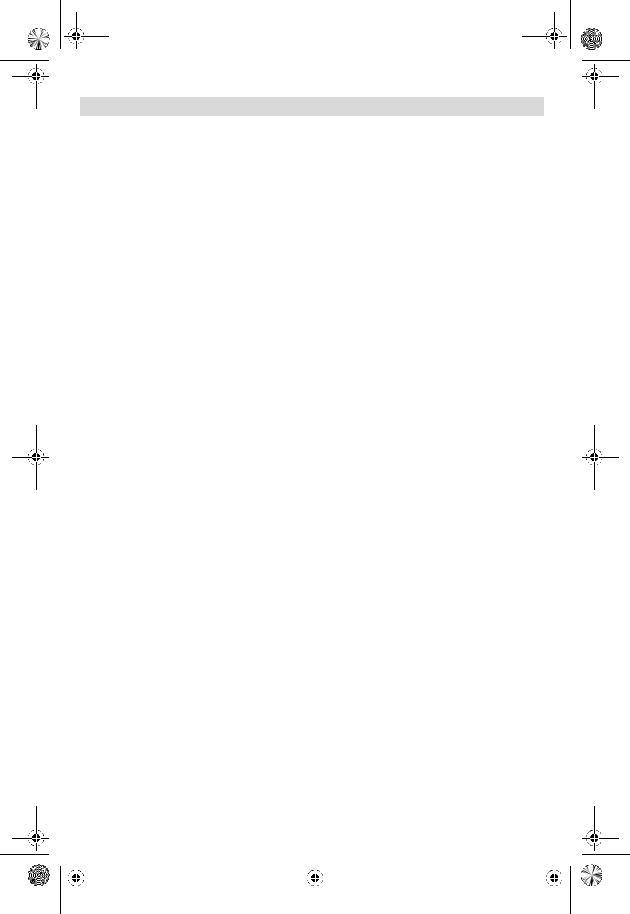
OBJ_BUCH-114-002.book Page 2 Tuesday, November 9, 2010 11:58 AM
2 |
Deutsch . . . . . . . . . . . . . . . . . . . . . . . . |
. . . . Seite |
4 |
English . . . . . . . . . . . . . . . . . . . . . . . . . . |
. . . Page |
12 |
Français . . . . . . . . . . . . . . . . . . . . . . . . . |
. . . Page |
21 |
Español. . . . . . . . . . . . . . . . . . . . . . . . . . |
. .Página |
30 |
Português . . . . . . . . . . . . . . . . . . . . . . . . |
. .Página |
39 |
Italiano . . . . . . . . . . . . . . . . . . . . . . . . . . |
. .Pagina |
47 |
Nederlands . . . . . . . . . . . . . . . . . . . . . . . |
. .Pagina |
56 |
Dansk . . . . . . . . . . . . . . . . . . . . . . . . . . . |
. . . Side |
64 |
Svenska . . . . . . . . . . . . . . . . . . . . . . . . . |
. . . Sida |
71 |
Norsk . . . . . . . . . . . . . . . . . . . . . . . . . . . |
. . . Side |
78 |
Suomi . . . . . . . . . . . . . . . . . . . . . . . . . . . |
. . . .Sivu |
85 |
Ελληνικά . . . . . . . . . . . . . . . . . . . . . . . . . |
. . Σελίδα |
92 |
Türkçe . . . . . . . . . . . . . . . . . . . . . . . . . . |
. . . Sayfa |
101 |
Polski . . . . . . . . . . . . . . . . . . . . . . . . . . . |
. . Strona |
108 |
Česky . . . . . . . . . . . . . . . . . . . . . . . . . . . |
. . Strana |
116 |
Slovensky . . . . . . . . . . . . . . . . . . . . . . . . |
. . Strana |
123 |
Magyar . . . . . . . . . . . . . . . . . . . . . . . . . . |
. . . Oldal |
131 |
Русский . . . . . . . . . . . . . . . . . . . . . . . . |
Страница |
139 |
Українська . . . . . . . . . . . . . . . . . . . . . . . |
Сторінка |
148 |
Română . . . . . . . . . . . . . . . . . . . . . . . . . |
. . Pagina |
156 |
Български . . . . . . . . . . . . . . . . . . . . . . |
Страница |
164 |
Srpski . . . . . . . . . . . . . . . . . . . . . . . . . . . |
. . Strana |
173 |
Slovensko . . . . . . . . . . . . . . . . . . . . . . . . |
. . . Stran |
180 |
Hrvatski . . . . . . . . . . . . . . . . . . . . . . . . . |
Stranica |
188 |
Eesti . . . . . . . . . . . . . . . . . . . . . . . . . . . . |
Lehekülg |
195 |
Latviešu . . . . . . . . . . . . . . . . . . . . . . . . . |
Lappuse |
202 |
Lietuviškai . . . . . . . . . . . . . . . . . . . . . . . |
Puslapis |
210 |
. . . . . . . . . . . . . . . . . . . . . . . . . . . . . |
. . . . . 218 |
|
. . . . . . . . . . . . . . . . . . . . . . . . . . . . . |
. . . . . 224 |
|
. . . . . . . . . . . . . . . . . . . . . . . . . . . |
. . . . . . 230 |
|
. . . . . . . . . . . . . . . . . . . . . . . . . . |
. . . . |
236 |
Bahasa Indonesia . . . . . . . . . . . . . . . . . . |
Halaman |
243 |
Tiøng Vi·t . . . . . . . . . . . . . . . . . . . . . . . . |
. . .Trang |
251 |
. . . . . . . . . . . . . . . . . . . . . . . . . . . . |
. . . ΔΤϔλ |
258 |
vÝ—U . . . . . . . . . . . . . . . . . . . . . . . . . . |
. . . ϪΤϔλ |
264 |
|
|
1 609 929 W83 | (9.11.10) |
|
|
Bosch Power Tools |
|
|
||
|
|
|
|
|
|
|
|
|
|
|
|
|
|
|
|
|
|
|
|
|
|
|
|
|
|
|
|
|
|

OBJ_BUCH-114-002.book Page 3 Tuesday, November 9, 2010 11:58 AM |
|
3 | |
|
|
1 |
13 |
|
12 |
2 |
|
|
|
3 |
|
14 |
|
14 |
11 |
14 |
10 |
4 |
|
|
|
5 |
9 |
|
8 |
|
7 |
|
7 |
|
6 |
|
|
GDB 2500 WE |
|
Professional |
1 609 929 W83 | (9.11.10) |
Bosch Power Tools |
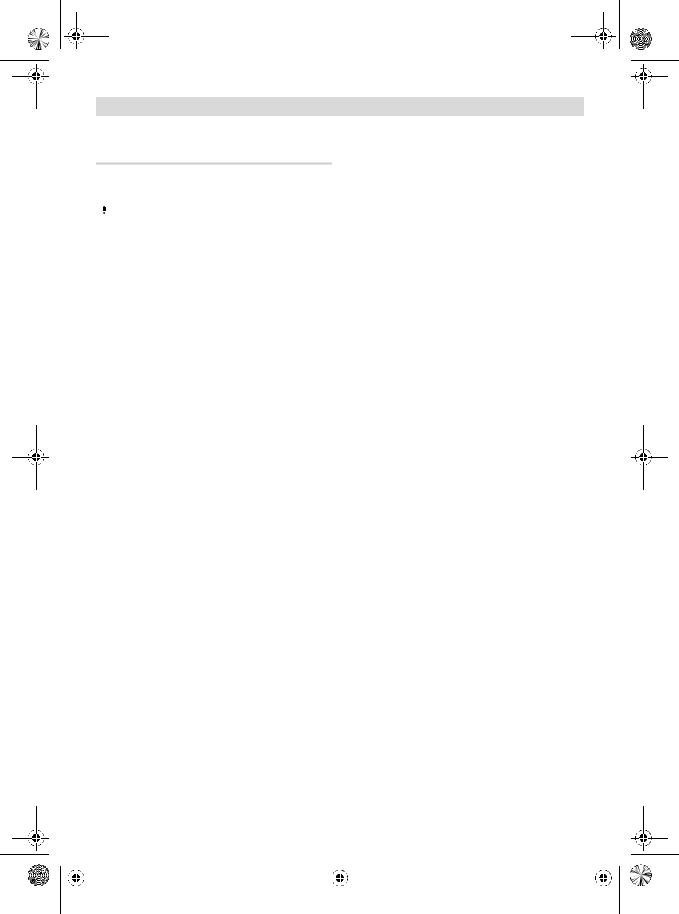
OBJ_BUCH-114-002.book Page 4 Tuesday, November 9, 2010 11:58 AM
4 | Deutsch
Sicherheitshinweise
Allgemeine Sicherheitshinweise für Elektrowerkzeuge
|
Beim Gebrauch von Elektro- |
|
ACHTUNG |
||
werkzeugen sind zum Schutz |
||
|
gegen elektrischen Schlag, Verletzungsund Brandgefahr folgende grundsätzliche Sicherheitsmaßnahmen zu beachten.
Lesen Sie alle diese Hinweise, bevor Sie dieses Elektrowerkzeug benutzen, und bewahren Sie die Sicherheitshinweise gut auf.
Der in den Sicherheitshinweisen verwendete Begriff „Elektrowerkzeug“ bezieht sich auf netzbetriebene Elektrowerkzeuge (mit Netzkabel) und auf akkubetriebene Elektrowerkzeuge (ohne Netzkabel).
1)Arbeitsplatzsicherheit
a)Halten Sie Ihren Arbeitsbereich sauber und gut beleuchtet. Unordnung oder unbeleuchtete Arbeitsbereiche können zu Unfällen führen.
b)Arbeiten Sie mit dem Elektrowerkzeug nicht in explosionsgefährdeter Umgebung, in der sich brennbare Flüssigkeiten, Gase oder Stäube befinden. Elektrowerkzeuge erzeugen Funken, die den Staub oder die Dämpfe entzünden können.
c)Halten Sie Kinder und andere Personen während der Benutzung des Elektrowerkzeugs fern. Bei Ablenkung können Sie die Kontrolle über das Gerät verlieren.
2)Elektrische Sicherheit
a)Der Anschlussstecker des Elektrowerkzeuges muss in die Steckdose passen. Der Stecker darf in keiner Weise verändert werden. Verwenden Sie keine Adapterstecker gemeinsam mit schutzgeerdeten Elektrowerkzeugen. Unveränderte Stecker und passende Steckdosen verringern das Risiko eines elektrischen Schlages.
b)Vermeiden Sie Körperkontakt mit geerdeten Oberflächen wie von Rohren, Heizungen, Herden und Kühlschränken. Es besteht ein erhöhtes Risiko durch elektrischen Schlag, wenn Ihr Körper geerdet ist.
c)Halten Sie Elektrowerkzeuge von Regen oder Nässe fern. Das Eindringen von Wasser in ein Elektrowerkzeug erhöht das Risiko eines elektrischen Schlages.
d)Zweckentfremden Sie das Kabel nicht, um das Elektrowerkzeug zu tragen, aufzuhängen oder um den Stecker aus der Steckdose zu ziehen. Halten Sie das Kabel fern von Hitze, Öl, scharfen Kanten oder sich bewegenden Geräteteilen. Beschädigte oder verwickelte Kabel erhöhen das Risiko eines elektrischen Schlages.
e)Wenn Sie mit einem Elektrowerkzeug im Freien arbeiten, verwenden Sie nur Verlängerungskabel, die auch für den Außenbereich geeignet sind. Die Anwendung eines für den Außenbereich geeigneten Verlängerungskabels verringert das Risiko eines elektrischen Schlages.
3)Sicherheit von Personen
a)Seien Sie aufmerksam, achten Sie darauf, was Sie tun, und gehen Sie mit Vernunft an die Arbeit mit einem Elektrowerkzeug. Benutzen Sie kein Elektrowerkzeug, wenn Sie müde sind oder unter dem Einfluss von Drogen, Alkohol oder Medikamenten stehen. Ein Moment der Unachtsamkeit beim Gebrauch des Elektrowerkzeuges kann zu ernsthaften Verletzungen führen.
b)Tragen Sie persönliche Schutzausrüstung und immer eine Schutzbrille. Das Tragen persönlicher Schutzausrüstung, wie Staubmaske, rutschfeste Sicherheitsschuhe, Schutzhelm oder Gehörschutz, je nach Art und Einsatz des Elektrowerkzeuges, verringert das Risiko von Verletzungen.
c)Vermeiden Sie eine unbeabsichtigte Inbetriebnahme. Vergewissern Sie sich, dass das Elektrowerkzeug ausgeschaltet ist, bevor Sie es an die Stromversorgung und/oder den Akku anschließen, es aufnehmen oder tragen. Wenn Sie beim Tragen des Elektrowerkzeuges den Finger am Schalter haben oder das Gerät eingeschaltet an die Stromversorgung anschließen, kann dies zu Unfällen führen.
|
|
1 609 929 W83 | (9.11.10) |
|
|
Bosch Power Tools |
|
|
||
|
|
|
|
|
|
|
|
|
|
|
|
|
|
|
|
|
|
|
|
|
|
|
|
|
|
|
|
|
|
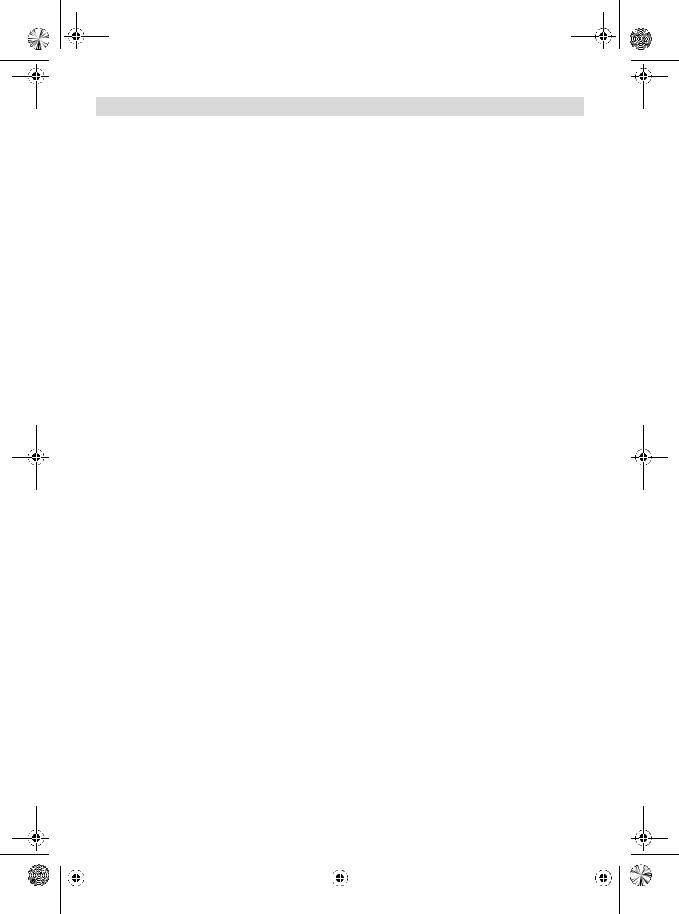
OBJ_BUCH-114-002.book Page 5 Tuesday, November 9, 2010 11:58 AM
d)Entfernen Sie Einstellwerkzeuge oder Schraubenschlüssel, bevor Sie das Elektrowerkzeug einschalten. Ein Werkzeug oder Schlüssel, der sich in einem drehenden Geräteteil befindet, kann zu Verletzungen führen.
e)Vermeiden Sie eine abnormale Körperhaltung. Sorgen Sie für einen sicheren Stand und halten Sie jederzeit das Gleichgewicht. Dadurch können Sie das Elektrowerkzeug in unerwarteten Situationen besser kontrollieren.
f)Tragen Sie geeignete Kleidung. Tragen Sie keine weite Kleidung oder Schmuck. Halten Sie Haare, Kleidung und Handschuhe fern von sich bewegenden Teilen.
Lockere Kleidung, Schmuck oder lange Haare können von sich bewegenden Teilen erfasst werden.
g)Wenn Staubabsaugund -auffangein- richtungen montiert werden können, vergewissern Sie sich, dass diese angeschlossen sind und richtig verwendet werden. Verwendung einer Staubabsaugung kann Gefährdungen durch Staub verringern.
4)Verwendung und Behandlung des Elektrowerkzeuges
a)Überlasten Sie das Gerät nicht. Verwenden Sie für Ihre Arbeit das dafür bestimmte Elektrowerkzeug. Mit dem passenden Elektrowerkzeug arbeiten Sie besser und sicherer im angegebenen Leistungsbereich.
b)Benutzen Sie kein Elektrowerkzeug, dessen Schalter defekt ist. Ein Elektrowerkzeug, das sich nicht mehr einoder ausschalten lässt, ist gefährlich und muss repariert werden.
c)Ziehen Sie den Stecker aus der Steckdose und/oder entfernen Sie den Akku, bevor Sie Geräteeinstellungen vornehmen, Zubehörteile wechseln oder das Gerät weglegen. Diese Vorsichtsmaßnahme verhindert den unbeabsichtigten Start des Elektrowerkzeuges.
Deutsch | 5
d)Bewahren Sie unbenutzte Elektrowerkzeuge außerhalb der Reichweite von Kindern auf. Lassen Sie Personen das Gerät nicht benutzen, die mit diesem nicht vertraut sind oder diese Anweisungen nicht gelesen haben. Elektrowerkzeuge sind gefährlich, wenn sie von unerfahrenen Personen benutzt werden.
e)Pflegen Sie Elektrowerkzeuge mit Sorgfalt. Kontrollieren Sie, ob bewegliche Teile einwandfrei funktionieren und nicht klemmen, ob Teile gebrochen oder so beschädigt sind, dass die Funktion des Elektrowerkzeuges beeinträchtigt ist. Lassen Sie beschädigte Teile vor dem Einsatz des Gerätes reparieren. Viele Unfälle haben ihre Ursache in schlecht gewarteten Elektrowerkzeugen.
f)Halten Sie Schneidwerkzeuge scharf und sauber. Sorgfältig gepflegte Schneidwerkzeuge mit scharfen Schneidkanten verklemmen sich weniger und sind leichter zu führen.
g)Verwenden Sie Elektrowerkzeug, Zubehör, Einsatzwerkzeuge usw. entsprechend diesen Anweisungen. Berücksichtigen Sie dabei die Arbeitsbedingungen und die auszuführende Tätigkeit. Der Gebrauch von Elektrowerkzeugen für andere als die vorgesehenen Anwendungen kann zu gefährlichen Situationen führen.
5)Service
a)Lassen Sie Ihr Elektrowerkzeug nur von qualifiziertem Fachpersonal und nur mit Original-Ersatzteilen reparieren. Damit wird sichergestellt, dass die Sicherheit des Elektrowerkzeuges erhalten bleibt.
|
|
Bosch Power Tools |
|
|
1 609 929 W83 | (9.11.10) |
|
|
||
|
|
|
|
|
|
|
|
|
|
|
|
|
|
|
|
|
|
|
|
|
|
|
|
|
|
|
|
|
|
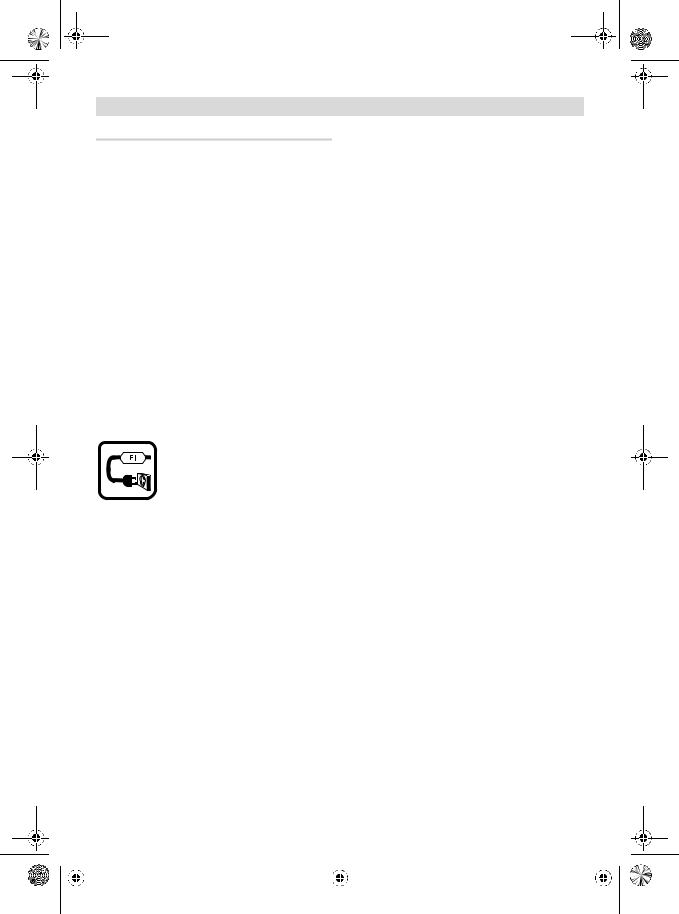
OBJ_BUCH-114-002.book Page 6 Tuesday, November 9, 2010 11:58 AM
6 | Deutsch
Sicherheitshinweise für Diamantbohrmaschinen
fHalten Sie das Elektrowerkzeug nur an den isolierten Griffflächen des Bohrständers, wenn Sie Arbeiten ausführen, bei denen das Einsatzwerkzeug verborgene Stromleitungen oder das eigene Netzkabel treffen kann. Der Kontakt mit einer spannungsführenden Leitung kann auch metallene Geräteteile unter Spannung setzen und zu einem elektrischen Schlag führen.
fVerwenden Sie geeignete Suchgeräte, um verborgene Versorgungsleitungen aufzuspüren, oder ziehen Sie die örtliche Versorgungsgesellschaft hinzu. Kontakt mit Elektroleitungen kann zu Feuer und elektrischem Schlag führen. Beschädigung einer Gasleitung kann zur Explosion führen. Eindringen in eine Wasserleitung verursacht Sachbeschädigung oder kann einen elektrischen Schlag verursachen.
Verwenden Sie das Elektrowerkzeug niemals ohne den mitgelieferten Fehlerstrom-(FI-)Schutz- schalter.
fÜberprüfen Sie vor Arbeitsbeginn die ordnungsgemäße Funktion des FI-Schutzschal- ters. Lassen Sie beschädigte FI-Schutzschal- ter bei einer Bosch-Kundendienststelle reparieren oder auswechseln.
fAchten Sie darauf, dass weder Personen im Arbeitsbereich noch das Elektrowerkzeug mit dem austretenden Wasser in Kontakt kommen.
fAchten Sie darauf, dass wasserführende Schläuche, Verbindungsteile sowie der Wasserfangring (Zubehör) in einwandfreiem Zustand sind. Wechseln Sie beschädigte oder verschlissene Teile vor dem nächsten Gebrauch. Der Austritt von Wasser aus Teilen des Elektrowerkzeugs erhöht das Risiko eines elektrischen Schlages.
fBewahren Sie das unbenutzte Elektrowerkzeug sicher auf. Der Lagerplatz muss trocken und abschließbar sein. Dies verhindert, dass das Elektrowerkzeug durch die Lagerung beschädigt oder von unerfahrenen Personen bedient wird.
fHalten Sie Griffe trocken, sauber und frei von Öl und Fett. Fettige, ölige Griffe sind rutschig und führen zu Verlust der Kontrolle.
fBenutzen Sie das Elektrowerkzeug nicht mit beschädigtem Kabel. Berühren Sie das beschädigte Kabel nicht und ziehen Sie den Netzstecker, wenn das Kabel während des Arbeitens beschädigt wird. Beschädigte Kabel erhöhen das Risiko eines elektrischen Schlages.
fUntersuchen Sie regelmäßig das Kabel und lassen Sie ein beschädigtes Kabel nur von einer autorisierten Kundendienststelle für Bosch-Elektrowerkzeuge reparieren. Ersetzen Sie beschädigte Verlängerungskabel.
Damit wird sichergestellt, dass die Sicherheit des Elektrowerkzeuges erhalten bleibt.
fTragen Sie rutschfeste Schuhe. Dadurch vermeiden Sie Verletzungen, die durch Ausrutschen auf glatten Flächen entstehen können.
fVerwenden Sie nur original Bosch-Zubehör.
fDie Sicherheitsund Arbeitshinweise für den verwendeten Bohrständer und das verwendete Zubehör sind strikt zu beachten!
fVerlassen Sie das Werkzeug nie, bevor es vollständig zum Stillstand gekommen ist.
Nachlaufende Einsatzwerkzeuge können Verletzungen verursachen.
fSchließen Sie das Elektrowerkzeug an ein ordnungsgemäß geerdetes Stromnetz an.
Steckdose und Verlängerungskabel müssen einen funktionsfähigen Schutzleiter besitzen.
|
|
1 609 929 W83 | (9.11.10) |
|
|
Bosch Power Tools |
|
|
||
|
|
|
|
|
|
|
|
|
|
|
|
|
|
|
|
|
|
|
|
|
|
|
|
|
|
|
|
|
|
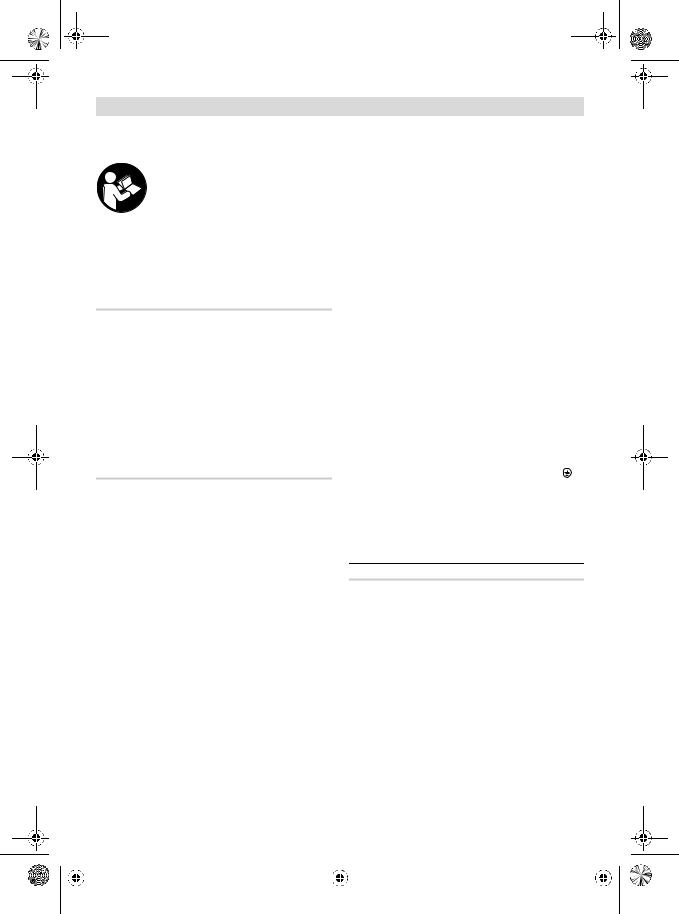
OBJ_BUCH-114-002.book Page 7 Tuesday, November 9, 2010 11:58 AM
Funktionsbeschreibung
Lesen Sie alle Sicherheitshinweise und Anweisungen. Versäumnisse
bei der Einhaltung der Sicherheits-
hinweise und Anweisungen können elektrischen Schlag, Brand und/oder schwere Verletzungen verursachen.
Bitte klappen Sie die Aufklappseite mit der Darstellung des Elektrowerkzeugs auf, und lassen Sie diese Seite aufgeklappt, während Sie die Betriebsanleitung lesen.
Bestimmungsgemäßer Gebrauch
Das Elektrowerkzeug ist in Verbindung mit Dia- mant-Nassbohrkronen und einer Wasserzuführung zum Nassbohren in mineralischen Werkstoffen wie Beton, Stahlbeton oder Mauerwerk bestimmt. Es ist nicht geeignet zum ÜberkopfBohren. Das Elektrowerkzeug darf nur in Verbindung mit dem Diamantbohrständer S 500 A verwendet werden. Das Elektrowerkzeug kann mit einer Absaugvorrichtung (Wasserfangring und Allzwecksauger) kombiniert werden.
Abgebildete Komponenten
Die Nummerierung der abgebildeten Komponenten bezieht sich auf die Darstellung des Elektrowerkzeuges auf der Grafikseite.
1Diamantbohrständer S 500 A*
2FI-Schutzschalter
3Hahnanschlussstück
4Gangwahlschalter
5Vorschubkurbel (S 500 A)
6Wasserfangring*
7Bohrkrone*
8Gleitring*
9Bohrspindel
10Wasserdurchfluss-Anzeige
11Wasserabsperrhahn
12Kontrollleuchte
13Ein-/Ausschalter
14Isolierte Griffflächen
*Abgebildetes oder beschriebenes Zubehör gehört nicht zum Standard-Lieferumfang. Das vollständige Zubehör finden Sie in unserem Zubehörprogramm.
|
|
|
Deutsch | 7 |
|
|
|
|
Technische Daten |
|
|
|
|
|
|
|
Diamantbohrmaschine |
|
GDB 2500 WE |
|
|
|
|
Professional |
Sachnummer |
|
|
0 601 18P 7.. |
Nennaufnahme- |
|
|
|
leistung |
|
W |
2500 |
Abgabeleistung |
|
W |
1450 |
Nenndrehzahl n0 |
|
min-1 |
|
– 1. Gang |
|
440 |
|
– 2. Gang |
|
min-1 |
960 |
Bohrdurchmesser |
|
|
|
– optimaler Bereich |
|
mm |
82–132 |
– möglicher Bereich |
|
mm |
32–212 |
Werkzeugaufnahme |
|
|
1 1/4" UNC, |
|
|
|
G 1/2" |
max. Druck Wasser- |
|
|
|
versorgung |
|
bar |
6 |
Gewicht entspre- |
|
|
|
chend EPTA-Proce- |
|
|
|
dure 01/2003 |
|
kg |
11,8 |
Schutzklasse |
|
|
/I |
|
|
|
|
Die Angaben gelten für eine Nennspannung [U] von 230 V. Bei abweichenden Spannungen und in länderspezifischen Ausführungen können diese Angaben variieren.
Bitte beachten Sie die Sachnummer auf dem Typenschild Ihres Elektrowerkzeugs. Die Handelsbezeichnungen einzelner Elektrowerkzeuge können variieren.
Geräusch-/Vibrationsinformation
Messwerte für Geräusch ermittelt entsprechend EN 61029.
Der A-bewertete Geräuschpegel des Elektrowerkzeugs beträgt typischerweise: Schalldruckpegel 89 dB(A); Schallleistungspegel
100 dB(A). Unsicherheit K= 3 dB.
Gehörschutz tragen!
Schwingungsgesamtwerte (Vektorsumme dreier Richtungen) ermittelt entsprechend EN 61029: Schwingungsemissionswert ah = 3 m/s2, Unsicherheit K = 1,5 m/s2.
|
|
Bosch Power Tools |
|
|
1 609 929 W83 | (9.11.10) |
|
|
||
|
|
|
|
|
|
|
|
|
|
|
|
|
|
|
|
|
|
|
|
|
|
|
|
|
|
|
|
|
|
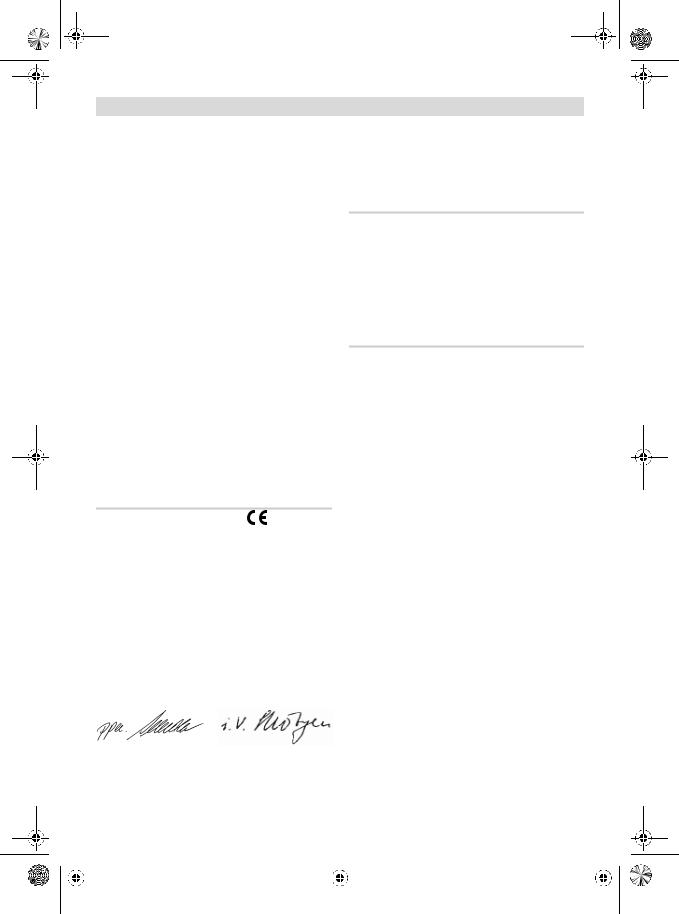
OBJ_BUCH-114-002.book Page 8 Tuesday, November 9, 2010 11:58 AM
8 | Deutsch
Der in diesen Anweisungen angegebene Schwingungspegel ist entsprechend einem in EN 61029 genormten Messverfahren gemessen worden und kann für den Vergleich von Elektrowerkzeugen miteinander verwendet werden. Er eignet sich auch für eine vorläufige Einschätzung der Schwingungsbelastung.
Der angegebene Schwingungspegel repräsentiert die hauptsächlichen Anwendungen des Elektrowerkzeugs. Wenn allerdings das Elektrowerkzeug für andere Anwendungen, mit abweichenden Einsatzwerkzeugen oder ungenügender Wartung eingesetzt wird, kann der Schwingungspegel abweichen. Dies kann die Schwingungsbelastung über den gesamten Arbeitszeitraum deutlich erhöhen. Für eine genaue Abschätzung der Schwingungsbelastung sollten auch die Zeiten berücksichtigt werden, in denen das Gerät abgeschaltet ist oder zwar läuft, aber nicht tatsächlich im Einsatz ist. Dies kann die Schwingungsbelastung über den gesamten Arbeitszeitraum deutlich reduzieren. Legen Sie zusätzliche Sicherheitsmaßnahmen zum Schutz des Bedieners vor der Wirkung von Schwingungen fest wie zum Beispiel: Wartung von Elektrowerkzeug und Einsatzwerkzeugen, Warmhalten der Hände, Organisation der Arbeitsabläufe.
Konformitätserklärung
Wir erklären in alleiniger Verantwortung, dass das unter „Technische Daten“ beschriebene Produkt mit den folgenden Normen oder normativen Dokumenten übereinstimmt:
EN 61029 gemäß den Bestimmungen der Richtlinien 2004/108/EG, 2006/42/EG.
Technische Unterlagen bei: Robert Bosch GmbH, PT/ESC, D-70745 Leinfelden-Echterdingen
Dr. Egbert Schneider |
Dr. Eckerhard Strötgen |
Senior Vice President |
Head of Product |
Engineering |
Certification |
Robert Bosch GmbH, Power Tools Division
D-70745 Leinfelden-Echterdingen
Leinfelden, 05.10.2010
Montage
fZiehen Sie vor allen Arbeiten am Elektrowerkzeug den Netzstecker aus der Steckdose.
Einspannen in Diamantbohrständer
S 500 A
fDie Sicherheitsund Arbeitshinweise für den verwendeten Bohrständer sind strikt zu beachten!
Zum Einsetzen des Elektrowerkzeugs in den Bohrständer lesen und befolgen Sie dessen Betriebsanleitung.
Bohrkrone einsetzen/wechseln
fSichern Sie vor allen Arbeiten am Elektrowerkzeug, in Arbeitspausen sowie bei Nichtgebrauch das Elektrowerkzeug durch Einrasten der Vorschubarretierung gegen unbeabsichtigtes Bewegen. Lesen und befolgen Sie dazu die Betriebsanleitung des Bohrständers.
Bohrkrone einsetzen
fPrüfen Sie die Bohrkronen vor dem Einsetzen. Setzen Sie nur einwandfreie Bohrkronen ein. Beschädigte oder deformierte Bohrkronen können zu gefährlichen Situationen führen.
Reinigen Sie die Bohrkrone vor dem Einsetzen. Fetten Sie das Gewinde der Bohrkrone leicht oder sprühen Sie es mit Korrosionsschutz ein.
Schrauben Sie entweder eine G 1/2"-Bohrkrone in die Bohrspindel 9 ein oder eine 1 1/4"-UNC- Bohrkrone auf die Bohrspindel 9 auf.
fPrüfen Sie die Bohrkrone auf festen Sitz.
Falsch oder nicht sicher befestigte Bohrkronen können sich während des Betriebs lösen und Sie gefährden.
Das Einlegen eines Gleitrings 8 (Zubehör) zwischen Bohrspindel und 1 1/4"-UNC-Bohrkrone erleichtert das spätere Lösen der Bohrkrone.
|
|
1 609 929 W83 | (9.11.10) |
|
|
Bosch Power Tools |
|
|
||
|
|
|
|
|
|
|
|
|
|
|
|
|
|
|
|
|
|
|
|
|
|
|
|
|
|
|
|
|
|
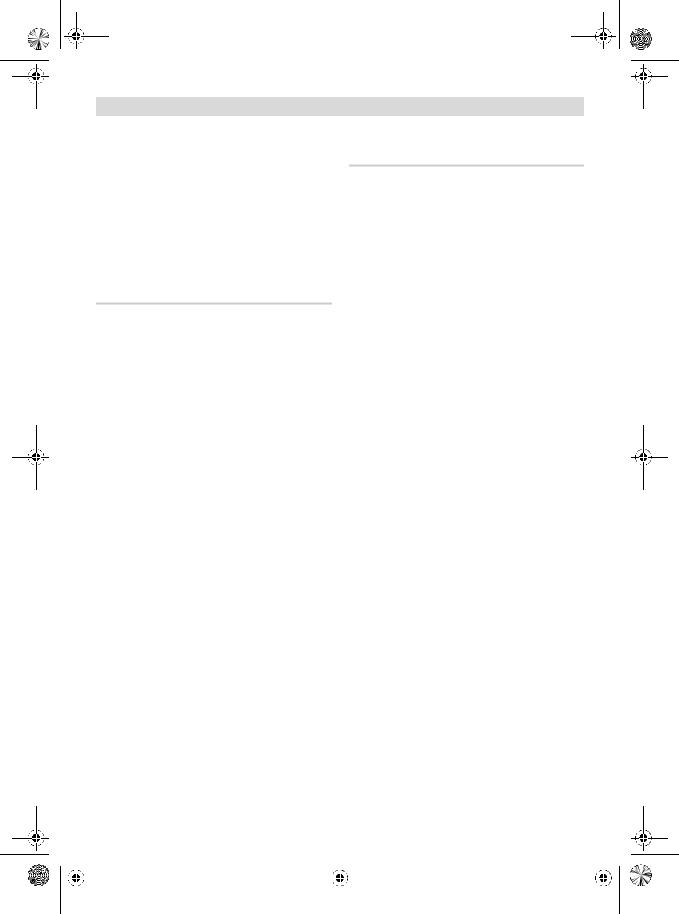
OBJ_BUCH-114-002.book Page 9 Tuesday, November 9, 2010 11:58 AM
Bohrkrone entnehmen
fTragen Sie beim Wechseln der Bohrkrone Schutzhandschuhe. Die Bohrkrone kann bei längerem Betrieb des Elektrowerkzeugs heiß werden.
Lösen Sie die Bohrkrone 7 mit einem Gabelschlüssel (1 1/4"-UNC-Bohrkrone: Schlüsselweite 41 mm; G 1/2"-Bohrkrone: Schlüsselweite 22 mm). Halten Sie dabei mit einem zweiten Gabelschlüssel (Schlüsselweite 36 mm) am Zweikant der Bohrspindel 9 gegen.
Wasserkühlung anschließen
Werden Nassbohrkronen beim Bohren nicht ausreichend gekühlt, können die Diamantsegmente beschädigt werden oder die Bohrkrone kann in der Bohrung blockieren. Achten Sie deshalb beim Nassbohren auf ausreichende Wasserzufuhr.
Bei der Vergrößerung einer vorhandenen Bohrung muss diese sorgfältig verschlossen werden, um eine ausreichende Kühlung der Bohrkrone zu ermöglichen.
fAngeschlossene Schläuche, Absperrventile oder Zubehör dürfen den Bohrvorgang nicht behindern.
Drehen Sie den Wasserabsperrhahn 11 zu. Schließen Sie eine Wasserzuleitung an das Hahnanschlussstück 3 an. Die Wasserzuleitung ist aus einem mobilen Wasserdruckbehälter (Zubehör) oder von einem stationären Wasseranschluss möglich.
Um das beim Nassbohren aus der Bohrung austretende Wasser aufzufangen, benötigen Sie einen Wasserfangring und einen Allzwecksauger (beide Zubehör).
Zur Montage des Wasserfangringes lesen und befolgen Sie dessen Betriebsanleitung.
Deutsch | 9
Betrieb
Inbetriebnahme
fBeachten Sie die Netzspannung! Die Spannung der Stromquelle muss mit den Angaben auf dem Typenschild des Elektrowerkzeuges übereinstimmen. Mit 230 V gekennzeichnete Elektrowerkzeuge können auch an 220 V betrieben werden.
fZiehen Sie vor Arbeitsbeginn den verantwortlichen Statiker, Architekten oder die zuständige Bauleitung über geplante Bohrungen zurate. Durchtrennen Sie Armierungen nur mit Genehmigung eines Baustatikers.
fKontrollieren Sie bei Bohrungen, die Wände oder den Boden durchbohren, unbedingt die betroffenen Räume auf Hindernisse. Sperren Sie die Baustelle ab und sichern Sie den Bohrkern mittels Schalung gegen Herunterfallen.
Funktionstest des FI-Schutzschalters
Überprüfen Sie die ordnungsgemäße Funktion des FI-Schutzschalters 2 vor jedem Arbeitsbeginn:
–Drücken Sie die „RESET“-Taste am FI-Schutz- schalter. Die Betriebsbereitschaft des Schutzschalters wird durch eine rote Kontrollanzeige signalisiert.
–Drücken Sie die „TEST“-Taste. Die Anzeige über der „RESET“-Taste wird schwarz.
Einschalten
Drücken Sie die „RESET“-Taste am FI-Schutz- schalter 2.
Stellen Sie den Wasserabsperrhahn 11 auf Durchfluss. Kontrollieren Sie den Wasserfluss an der Durchfluss-Anzeige 10.
Drehen Sie zum Anbohren mit halber Drehzahl den Ein-/Ausschalter 13 in Stellung 1/2. Der Schalter ist in dieser Stellung nicht arretierbar.
Drehen Sie zum Bohren den Ein-/Ausschalter 13 in Stellung I.
|
|
Bosch Power Tools |
|
|
1 609 929 W83 | (9.11.10) |
|
|
||
|
|
|
|
|
|
|
|
|
|
|
|
|
|
|
|
|
|
|
|
|
|
|
|
|
|
|
|
|
|

OBJ_BUCH-114-002.book Page 10 Tuesday, November 9, 2010 11:58 AM
10 | Deutsch
Ausschalten
Lassen Sie den Ein-/Ausschalter 13 los bzw. drehen Sie ihn in Stellung 0.
Drehen Sie den Wasserabsperrhahn 11 zu. Trennen Sie nach Arbeitsende das Hahnanschlussstück 3 von der Wasserzuleitung. Öffnen Sie den Wasserabsperrhahn 11 und lassen Sie das Restwasser ab.
Drehzahl einstellen
Mit dem Gangwahlschalter 4 können 2 Drehzahlbereiche vorgewählt werden.
Die beiden Gänge werden für folgende Bohrdurchmesser empfohlen:
1. Gang |
82–212 mm |
2. Gang |
32–132 mm |
Arbeitshinweise
fZiehen Sie vor allen Arbeiten am Elektrowerkzeug den Netzstecker aus der Steckdose.
Lösen Sie zum Bohren die Arretierung der Vorschubkurbel 5 (siehe Betriebsanleitung des Bohrständers).
Bohren Sie mit halber Drehzahl (Ein-/Ausschalter in Stellung 1/2) an, bis sich die Bohrkrone vibrationsfrei im Werkstoff dreht. Bohren Sie mit voller Drehzahl (Ein-/Ausschalter in Stellung I) weiter.
Passen Sie den Anpressdruck beim Bohren dem zu bohrenden Werkstoff an. Bohren Sie mit gleichmäßigem Druck. Ziehen Sie die Bohrkrone gelegentlich leicht aus der Bohrung zurück, damit der Bohrschlamm aus den Diamantsegmenten entfernt wird.
Überlasten Sie das Elektrowerkzeug nicht. Bei Überlastung blinkt die Kontrollleuchte 12 (siehe „Kontrollleuchte“).
Überlastkupplung
Klemmt oder hakt die Bohrkrone, wird der Antrieb der Bohrspindel unterbrochen. Schalten Sie in diesem Fall das Elektrowerkzeug ab und lösen Sie die Bohrkrone.
Kontrollleuchte
Die Kontrollleuchte 12 blinkt:
Das Elektrowerkzeug arbei-
tet im Überlastbereich.
Verringern Sie den Anpress-
druck. Schalten Sie das Elek-
trowerkzeug gegebenenfalls aus und schärfen Sie die Bohrkrone.
Wird der Anpressdruck nicht verringert, regelt die Elektronik die Drehzahl zurück, gegebenenfalls bis zum Stillstand. Nach der Entlastung läuft das Elektrowerkzeug automatisch wieder an.
Die Kontrollleuchte 12 leuchtet dauerhaft:
Die Kohlebürsten müssen
gewechselt werden.
Eine Bosch-Kundendienst- stelle führt diese Arbeit schnell und zuverlässig aus.
Bohrkern entfernen
Lassen Sie das Wasser nach dem Bohren kurz weiterlaufen, um den Bohrschlamm zwischen Bohrkrone und Bohrkern herauszuspülen.
Sitzt der Bohrkern in der Bohrkrone fest, dann schlagen Sie mit einem weichen Holz oder Kunststoffstück auf die Bohrkrone und lösen so den Bohrkern. Drücken Sie bei Bedarf den Bohrkern mit einem Stab durch das Einsteckende der Bohrkrone heraus.
Hinweis: Schlagen Sie nicht mit harten Gegenständen auf die Bohrkrone (Deformationsgefahr)!
|
|
1 609 929 W83 | (9.11.10) |
|
|
Bosch Power Tools |
|
|
||
|
|
|
|
|
|
|
|
|
|
|
|
|
|
|
|
|
|
|
|
|
|
|
|
|
|
|
|
|
|
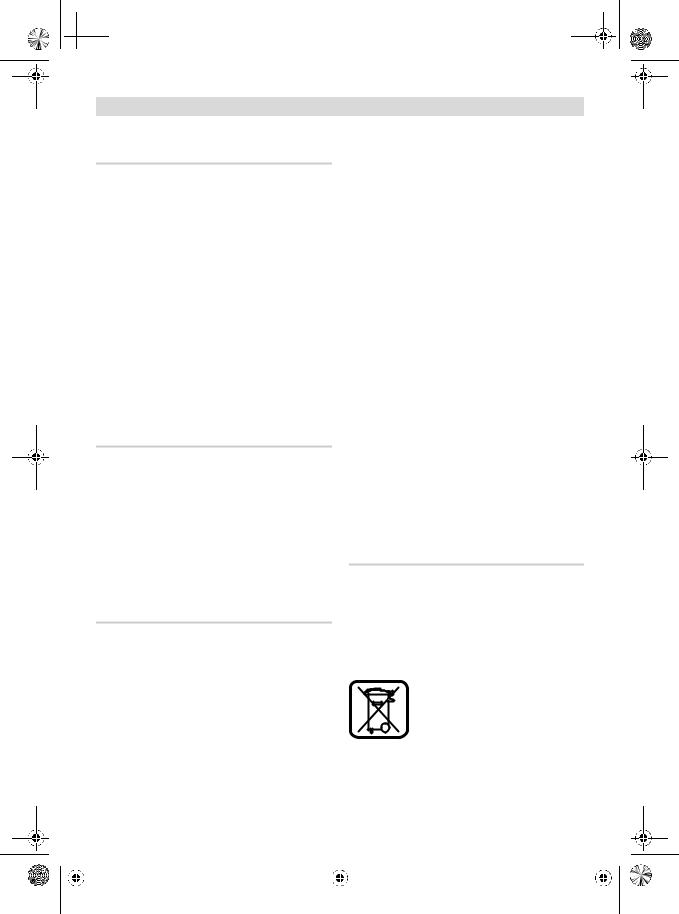
 OBJ_BUCH-114-002.book Page 11 Tuesday, November 9, 2010 11:58 AM
OBJ_BUCH-114-002.book Page 11 Tuesday, November 9, 2010 11:58 AM
Deutsch | 11
Wartung und Service
Wartung und Reinigung
fZiehen Sie vor allen Arbeiten am Elektrowerkzeug den Netzstecker aus der Steckdose.
fHalten Sie das Elektrowerkzeug und die Lüftungsschlitze sauber, um gut und sicher zu arbeiten.
Säubern Sie die Bohrspindel 9 nach Arbeitsende. Sprühen Sie die Bohrspindel und die Bohrkrone 7 gelegentlich mit Korrosionsschutzmittel ein.
Sollte das Elektrowerkzeug trotz sorgfältiger Herstellungsund Prüfverfahren einmal ausfallen, ist die Reparatur von einer autorisierten Kundendienststelle für Bosch-Elektrowerkzeuge ausführen zu lassen.
Geben Sie bei allen Rückfragen und Ersatzteilbestellungen bitte unbedingt die 10-stellige Sachnummer laut Typenschild des Elektrowerkzeuges an.
Zubehör/Ersatzteile
Diamantbohrständer S 500 A . . . 0 601 190 025 Wasserfangring . . . . . . . . . . . . . 2 609 390 389
Dichtungsdeckel für
Wasserfangring . . . . . . . . . . . . . 2 609 390 391 Wasserdruckbehälter . . . . . . . . . 2 609 390 308 Gleitring . . . . . . . . . . . . . . . . . . . 1 600 190 042
Verlängerung 300 mm:
–für Bohrkrone G 1/2" . . . . . . . 2 608 598 044
–für Bohrkrone 1 1/4" UNC . . . 2 608 598 045
Kundendienst und Kundenberatung
Der Kundendienst beantwortet Ihre Fragen zu Reparatur und Wartung Ihres Produkts sowie zu Ersatzteilen. Explosionszeichnungen und Informationen zu Ersatzteilen finden Sie auch unter: www.bosch-pt.com
Das Bosch-Kundenberater-Team hilft Ihnen gerne bei Fragen zu Kauf, Anwendung und Einstellung von Produkten und Zubehören.
www.powertool-portal.de, das Internetportal für Handwerker und Heimwerker. www.ewbc.de, der Informations-Pool für Handwerk und Ausbildung.
Deutschland
Robert Bosch GmbH Servicezentrum Elektrowerkzeuge Zur Luhne 2
37589 Kalefeld – Willershausen
Tel. Kundendienst: +49 (1805) 70 74 10* Fax: +49 (1805) 70 74 11*
(*Festnetzpreis 14 ct/min, höchstens 42 ct/min aus Mobilfunknetzen)
E-Mail: Servicezentrum.Elektrowerkzeuge@de.bosch.com Tel. Kundenberatung: +49 (1803) 33 57 99 (Festnetzpreis 9 ct/min, höchstens 42 ct/min aus Mobilfunknetzen)
Fax: +49 (711) 7 58 19 30
E-Mail: kundenberatung.ew@de.bosch.com
Österreich
Tel.: +43 (01) 7 97 22 20 10
Fax: +43 (01) 7 97 22 20 11
E-Mail: service.elektrowerkzeuge@at.bosch.com
Schweiz
Tel.: +41 (044) 8 47 15 11
Fax: +41 (044) 8 47 15 51
Luxemburg
Tel.: +32 (070) 22 55 65
Fax: +32 (070) 22 55 75
E-Mail: outillage.gereedschap@be.bosch.com
Weitere Informationen zum Diamantbohren finden Sie unter www.bosch-diamond.com.
Entsorgung
Elektrowerkzeuge, Zubehör und Verpackungen sollen einer umweltgerechten Wiederverwertung zugeführt werden.
Werfen Sie Elektrowerkzeuge nicht in den Hausmüll!
Nur für EU-Länder:
Gemäß der Europäischen Richtlinie 2002/96/EG über Elektround
Elektronik-Altgeräte und ihrer Umsetzung in nationales Recht müs-
sen nicht mehr gebrauchsfähige Elektrowerkzeuge getrennt gesam-
melt und einer umweltgerechten Wiederverwertung zugeführt werden.
Änderungen vorbehalten.
|
|
Bosch Power Tools |
|
|
1 609 929 W83 | (9.11.10) |
|
|
||
|
|
|
|
|
|
|
|
|
|
|
|
|
|
|
|
|
|
|
|
|
|
|
|
|
|
|
|
|
|
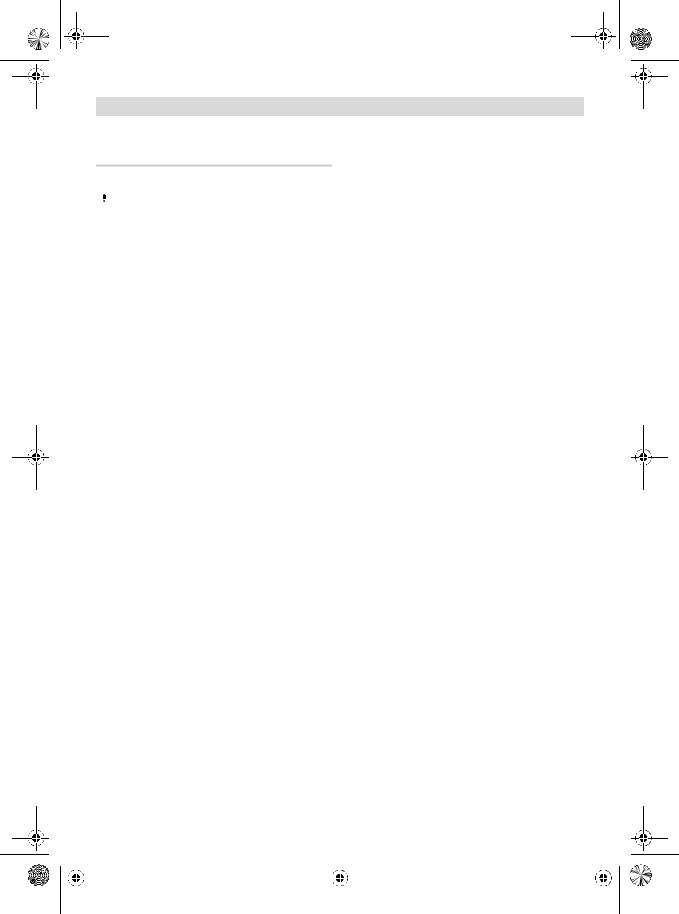
OBJ_BUCH-114-002.book Page 12 Tuesday, November 9, 2010 11:58 AM
12 | English
Safety Notes
General Power Tool Safety Warnings
|
When using electric tools basic |
WARNING |
|
|
safety precautions should |
|
always be followed to reduce the risk of fire, electric shock and personal injury including the following.
Read all these instructions before attempting to operate this product and save these instructions.
The term “power tool” in the warnings refers to your mains-operated (corded) power tool or battery-operated (cordless) power tool.
1)Work area safety
a)Keep work area clean and well lit. Cluttered or dark areas invite accidents.
b)Do not operate power tools in explosive atmospheres, such as in the presence of flammable liquids, gases or dust. Power tools create sparks which may ignite the dust or fumes.
c)Keep children and bystanders away while operating a power tool. Distractions can cause you to lose control.
2)Electrical safety
a)Power tool plugs must match the outlet. Never modify the plug in any way. Do not use any adapter plugs with earthed (grounded) power tools. Unmodified plugs and matching outlets will reduce risk of electric shock.
b)Avoid body contact with earthed or grounded surfaces, such as pipes, radiators, ranges and refrigerators. There is an increased risk of electric shock if your body is earthed or grounded.
c)Do not expose power tools to rain or wet conditions. Water entering a power tool will increase the risk of electric shock.
d)Do not abuse the cord. Never use the cord for carrying, pulling or unplugging the power tool. Keep cord away from heat, oil, sharp edges and moving parts.
Damaged or entangled cords increase the risk of electric shock.
e)When operating a power tool outdoors, use an extension cord suitable for outdoor use. Use of a cord suitable for outdoor use reduces the risk of electric shock.
3)Personal safety
a)Stay alert, watch what you are doing and use common sense when operating a power tool. Do not use a power tool while you are tired or under the influence of drugs, alcohol or medication. A moment of inattention while operating power tools may result in serious personal injury.
b)Use personal protective equipment. Always wear eye protection. Protective equipment such as dust mask, non-skid safety shoes, hard hat, or hearing protection used for appropriate conditions will reduce personal injuries.
c)Prevent unintentional starting. Ensure the switch is in the off-position before connecting to power source and/or battery pack, picking up or carrying the tool.
Carrying power tools with your finger on the switch or energising power tools that have the switch on invites accidents.
d)Remove any adjusting key or wrench before turning the power tool on. A wrench or a key left attached to a rotating part of the power tool may result in personal injury.
e)Do not overreach. Keep proper footing and balance at all times. This enables better control of the power tool in unexpected situations.
f)Dress properly. Do not wear loose clothing or jewellery. Keep your hair, clothing and gloves away from moving parts.
Loose clothes, jewellery or long hair can be caught in moving parts.
g)If devices are provided for the connection of dust extraction and collection facilities, ensure these are connected and properly used. Use of dust collection can reduce dust-related hazards.
|
|
1 609 929 W83 | (9.11.10) |
|
|
Bosch Power Tools |
|
|
||
|
|
|
|
|
|
|
|
|
|
|
|
|
|
|
|
|
|
|
|
|
|
|
|
|
|
|
|
|
|
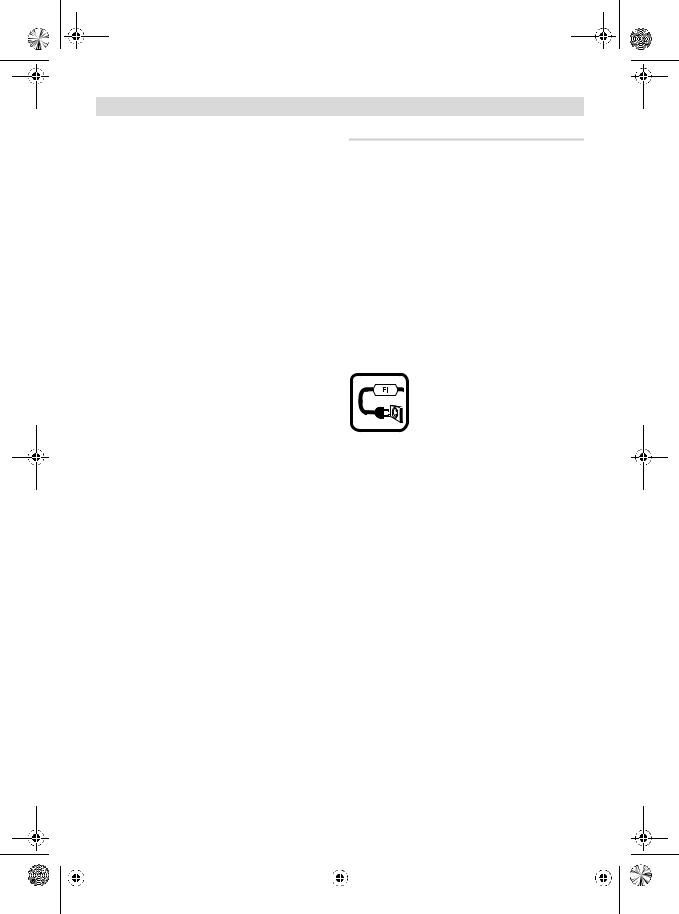
OBJ_BUCH-114-002.book Page 13 Tuesday, November 9, 2010 11:58 AM
4)Power tool use and care
a)Do not force the power tool. Use the correct power tool for your application. The correct power tool will do the job better and safer at the rate for which it was designed.
b)Do not use the power tool if the switch does not turn it on and off. Any power tool that cannot be controlled with the switch is dangerous and must be repaired.
c)Disconnect the plug from the power source and/or the battery pack from the power tool before making any adjustments, changing accessories, or storing power tools. Such preventive safety measures reduce the risk of starting the power tool accidentally.
d)Store idle power tools out of the reach of children and do not allow persons unfamiliar with the power tool or these instructions to operate the power tool.
Power tools are dangerous in the hands of untrained users.
e)Maintain power tools. Check for misalignment or binding of moving parts, breakage of parts and any other condition that may affect the power tool’s operation. If damaged, have the power tool repaired before use. Many accidents are caused by poorly maintained power tools.
f)Keep cutting tools sharp and clean. Properly maintained cutting tools with sharp cutting edges are less likely to bind and are easier to control.
g)Use the power tool, accessories and tool bits etc. in accordance with these instructions, taking into account the working conditions and the work to be performed.
Use of the power tool for operations different from those intended could result in a hazardous situation.
5)Service
a)Have your power tool serviced by a qualified repair person using only identical replacement parts. This will ensure that the safety of the power tool is maintained.
English | 13
Safety Warnings for Diamond Drills
fHold the power tool only by the insulated gripping surfaces of the drill stand when performing operations where the application tool could contact hidden wiring or its own power cord. Contact with a “live” wire will also make exposed metal parts of the power tool “live” and shock the operator.
fUse suitable detectors to determine if utility lines are hidden in the work area or call the local utility company for assistance.
Contact with electric lines can lead to fire and electric shock. Damaging a gas line can lead to explosion. Penetrating a water line causes property damage or may cause an electric shock.
Never operate the machine without the residual current device (RCD) provided.
fBefore starting work, check the proper function of the residual current device (RCD). Have a damaged residual current device (RCD) repaired or replaced by your Bosch after-sales service agent.
fPay attention that neither persons in the working area nor the power tool itself come into contact with the water that comes out.
fPay attention that water-conducting hoses, connnection elements and the water collection ring (accessory) are in proper condition. Replace damaged or worn parts before using the next time. Water coming out of power tool components increases the risk of electric shock.
fStore the machine in a safe manner when not being used. The storage location must be dry and lockable. This prevents the machine from storage damage, and from being operated by untrained persons.
fKeep handles dry, clean, and free from oil and grease. Greasy, oily handles are slippery causing loss of control.
|
|
Bosch Power Tools |
|
|
1 609 929 W83 | (9.11.10) |
|
|
||
|
|
|
|
|
|
|
|
|
|
|
|
|
|
|
|
|
|
|
|
|
|
|
|
|
|
|
|
|
|
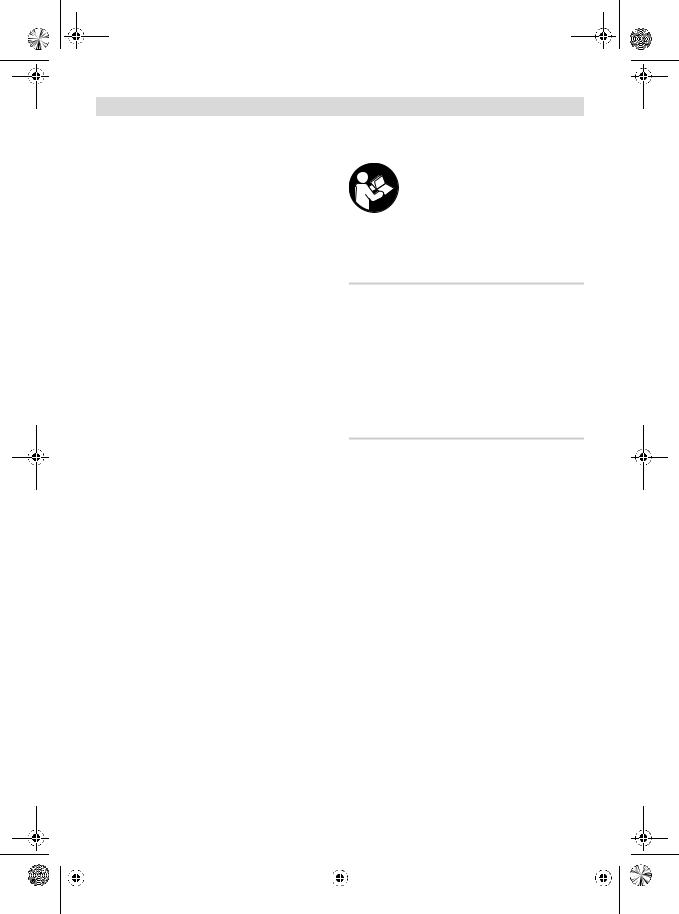
OBJ_BUCH-114-002.book Page 14 Tuesday, November 9, 2010 11:58 AM
14 | English
fNever use the machine with a damaged cable. Do not touch the damaged cable and pull the mains plug when the cable is damaged while working. Damaged cables increase the risk of an electric shock.
fCheck the cable regularly and have a damaged cable repaired only through an authorised customer service agent for Bosch power tools. Replace damaged extension cables.
This will ensure that the safety of the power tool is maintained.
fWear non-skid shoes. This prevents injuries that can occur from slipping on smooth surfaces.
fUse only original Bosch accessories.
fThe safety and operating instructions for the drill stand and the accessories being used are to be strictly observed!
fNever leave the machine before it has come to a complete stop. Cutting tools that are still running can cause injuries.
fConnect the machine to a mains supply with proper earthing connection. Socket outlet and extension cable must be equipped with an operative protective conductor.
fProducts sold in GB only: Your product is fitted with an BS 1363/A approved electric plug with internal fuse (ASTA approved to
BS 1362).
If the plug is not suitable for your socket outlets, it should be cut off and an appropriate plug fitted in its place by an authorised customer service agent. The replacement plug should have the same fuse rating as the original plug.
The severed plug must be disposed of to avoid a possible shock hazard and should never be inserted into a mains socket elsewhere.
Products sold in AUS and NZ only: Use a residual current device (RCD) with a rated residual current of 30 mA or less.
Functional Description
Read all safety warnings and all instructions. Failure to follow the
warnings and instructions may
result in electric shock, fire and/or serious injury.
While reading the operating instructions, unfold the graphics page for the machine and leave it open.
Intended Use
In conjunction with wet-drilling diamond core bits and a water supply, the machine is intended for wet drilling in mineral materials such as concrete and reinforced concrete. It is not suitable for overhead drilling. The machine may only be used in conjunction with the S 500 A diamonddrill stand. The machine can be used in combination with an extraction device (water collection ring and all-purpose vac).
Product Features
The numbering of the product features refers to the illustration of the machine on the graphics page.
1S 500 A diamond-drill stand*
2Residual current device (RCD)
3Water outlet connector
4Gear selector
5Feed handle (S 500 A)
6Water collection ring*
7Core bit*
8Sliding ring*
9Drill spindle
10Water-flow indicator
11Water cock
12Control indicator
13On/Off switch
14Insulated gripping surfaces
*Accessories shown or described are not part of the standard delivery scope of the product. A complete overview of accessories can be found in our accessories program.
|
|
1 609 929 W83 | (9.11.10) |
|
|
Bosch Power Tools |
|
|
||
|
|
|
|
|
|
|
|
|
|
|
|
|
|
|
|
|
|
|
|
|
|
|
|
|
|
|
|
|
|

OBJ_BUCH-114-002.book Page 15 Tuesday, November 9, 2010 11:58 AM
Technical Data
Diamond Drill |
|
GDB 2500 WE |
|
|
Professional |
Article number |
|
0 601 18P 7.. |
Rated power input |
W |
2500 |
Output power |
W |
1450 |
Rated speed n0 |
min-1 |
|
– 1. Gear |
440 |
|
– 2. Gear |
min-1 |
960 |
Drilling diameter |
|
|
– optimum range |
mm |
82–132 |
– possible range |
mm |
32–212 |
Tool holder |
|
1 1/4" UNC, |
|
|
G 1/2" |
Water supply |
|
|
pressure (max.) |
bar |
6 |
Weight according to |
|
|
EPTA-Procedure |
|
|
01/2003 |
kg |
11.8 |
Protection class |
|
/I |
|
|
|
The values given are valid for a nominal voltage [U] of 230 V. For different voltages and models for specific countries, these values can vary.
Please observe the article number on the type plate of your machine. The trade names of the individual machines may vary.
Noise/Vibration Information
Measured sound values determined according to EN 61029.
Typically the A-weighted noise levels of the product are: Sound pressure level 89 dB(A); Sound power level 100 dB(A). Uncertainty K = 3 dB.
Wear hearing protection!
Vibration total values (triax vector sum) determined according to EN 61029:
Vibration emission value ah = 3 m/s2, Uncertainty K = 1.5 m/s2.
English | 15
The vibration emission level given in this information sheet has been measured in accordance with a standardised test given in EN 61029 and may be used to compare one tool with another. It may be used for a preliminary assessment of exposure.
The declared vibration emission level represents the main applications of the tool. However if the tool is used for different applications, with different accessories or poorly maintained, the vibration emission may differ. This may significantly increase the exposure level over the total working period.
An estimation of the level of exposure to vibration should also take into account the times when the tool is switched off or when it is running but not actually doing the job. This may significantly reduce the exposure level over the total working period.
Identify additional safety measures to protect the operator from the effects of vibration such as: maintain the tool and the accessories, keep the hands warm, organisation of work patterns.
Declaration of Conformity
We declare under our sole responsibility that the product described under “Technical Data” is in conformity with the following standards or standardization documents: EN 61029 according to the provisions of the directives 2004/108/EC, 2006/42/EC.
Technical file at:
Robert Bosch GmbH, PT/ESC, D-70745 Leinfelden-Echterdingen
Dr. Egbert Schneider |
Dr. Eckerhard Strötgen |
Senior Vice President |
Head of Product |
Engineering |
Certification |
Robert Bosch GmbH, Power Tools Division
D-70745 Leinfelden-Echterdingen
Leinfelden, 05.10.2010
|
|
Bosch Power Tools |
|
|
1 609 929 W83 | (9.11.10) |
|
|
||
|
|
|
|
|
|
|
|
|
|
|
|
|
|
|
|
|
|
|
|
|
|
|
|
|
|
|
|
|
|
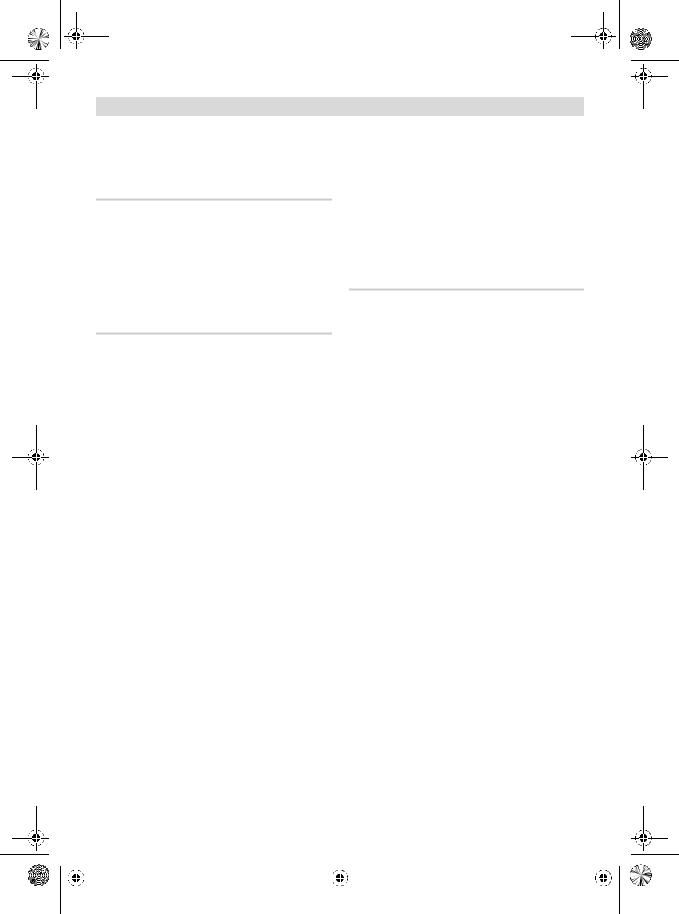
OBJ_BUCH-114-002.book Page 16 Tuesday, November 9, 2010 11:58 AM
16 | English
Assembly
fBefore any work on the machine itself, pull the mains plug.
Clamping the Machine in the S 500 A
Diamond-drill Stand
fThe safety and operating instructions for the drill stand being used are to be strictly observed!
For mounting the power tool into the drill stand, please read and observe the operating instructions of the drill stand.
Inserting/Replacing the Core Bit
fBefore any work on the machine itself, for longer work breaks, as well as when not using, secure the power tool against unintentional motion by engaging the feed lock. For this, read and observe the operating instructions of the drill stand.
Inserting a Core Bit
fExamine the core bit before inserting it. Use only core bits that are in perfect condition. Damaged or deformed core bits can lead to dangerous situations.
Clean the core bit before inserting it. Apply a light coat of grease to the core bit thread or spray on a corrosion protection agent.
Either screw a G 1/2" core bit into drill spindle 9 or a 1 1/4" UNC core bit onto drill spindle 9.
fCheck the proper seating of the core bit. Incorrectly or unsecurely fastened core bits can become loose during operation and may pose a danger.
Inserting a sliding ring 8 (accessory) between the drill spindle and the 1 1/4"-UNC core bit provide for easier loosening of the core bit after use.
Removing a Core Bit
fWear protective gloves when replacing the core bit. The core bit can become hot after prolonged operation of the power tool.
Loosen core bit 7 with an open-end spanner (1 1/4" UNC core bit: Spanner size, 41 mm;
G 1/2" core bit: Spanner size, 22 mm). When doing this, counter-hold the bore spindle 9 by the flats using a second open-end spanner (spanner size, 36 mm).
Connecting the Water Cooling
When wet-drilling core bits are not sufficiently cooled during drilling, the diamond segments can become damaged or the core bit can become jammed in the bore hole. Therefore, provide for a sufficient water supply during wet drilling.
When boring out a given bore, the given bore must be carefully plugged in order to enable sufficient cooling of the core bit.
fConnected hoses, shut-off valves or accessories must not obstruct or hinder the drilling process.
Shut the water cock 11. Connect water supply to the water-outlet connector 3. The water supply is possible either via a mobile water-pres- sure container (accessory) or via stationary water connection.
In order to collect the water coming out of the bore during wet-drilling, a water collection ring and a multi-purpose vacuum cleaner are required (both accessories).
For assembly of the water collection ring, read and observe its operating instructions.
|
|
1 609 929 W83 | (9.11.10) |
|
|
Bosch Power Tools |
|
|
||
|
|
|
|
|
|
|
|
|
|
|
|
|
|
|
|
|
|
|
|
|
|
|
|
|
|
|
|
|
|
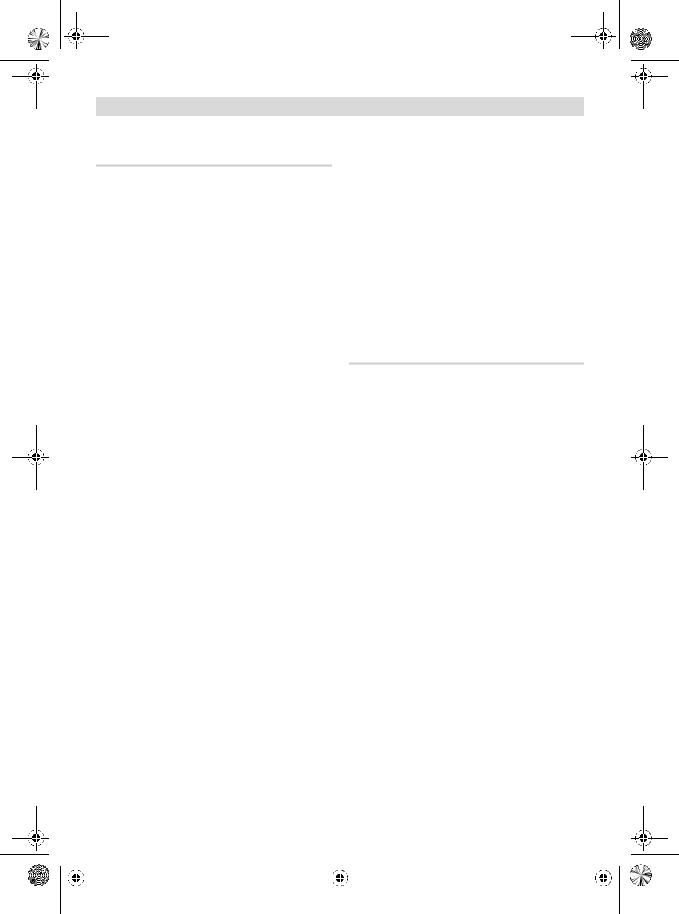
OBJ_BUCH-114-002.book Page 17 Tuesday, November 9, 2010 11:58 AM
Operation
Starting Operation
fObserve correct mains voltage! The voltage of the power source must agree with the voltage specified on the nameplate of the machine. Power tools marked with 230 V can also be operated with 220 V.
fBefore beginning work, consult the structural engineer, architect or construction supervisor in charge. Only cut through reinforcements with the permission of a structural engineer.
fWhen core drilling through walls or floors, ensure to check the respective rooms/enclosures for obstructions. Barrier off the construction site and secure the drilled out core against falling down with the use of casing or similar.
Operational Check of the Residual Current Device
Check the proper function of the residual current device 2 each time before working:
–Push the “RESET” button on the residual current device. The service readiness of the residual current device is signalled through a red control indicator.
–Push the “TEST” button. The indicator above the “RESET” button becomes black.
Switching On
Push the “RESET” button on the residual current device 2.
Open the water cock 11. Check the flow of water at the water-flow indicator 10.
For starting the drilling procedure at half speed, turn the On/Off switch 13 to the 1/2 position. The switch cannot be locked in this position.
For drilling, turn the On/Off switch 13 to the I position.
English | 17
Switching Off
Release the On/Off switch 13 or turn it to the 0 position.
Shut the water cock 11. After finishing work, disconnect the water outlet connector 3 from the water supply. Open the water cock 11 and drain the remaining water.
Adjusting the Speed
Two speed ranges can be preselected with the gear selector 4.
The two gears are recommended for the following bore diameters:
1st gear |
82–212 mm |
2nd gear |
32–132 mm |
Working Advice
fBefore any work on the machine itself, pull the mains plug.
For drilling, release the lock of the feed handle 5 (see operating instructions of the drill stand).
Start the drilling procedure at half speed (On/Off switch in the 1/2 position) until the core bit rotates vibration-free in the material. Then continue drilling at full speed (On/Off switch in the I position).
While drilling, adapt the feed pressure to the material being drilled. Drill with uniform pressure. Lightly pull the core bit out of the bore from time to time so that the drilling sludge is removed from the core bit segments.
Do not overload the machine. The control indicator 12 flashes in case of overload (see “Control Indicator”).
Safety Clutch
If the core bit becomes caught or jammed, the drive to the drill spindle is interrupted. In this case, switch the machine off and free the core bit.
|
|
Bosch Power Tools |
|
|
1 609 929 W83 | (9.11.10) |
|
|
||
|
|
|
|
|
|
|
|
|
|
|
|
|
|
|
|
|
|
|
|
|
|
|
|
|
|
|
|
|
|

OBJ_BUCH-114-002.book Page 18 Tuesday, November 9, 2010 11:58 AM
18 | English
Control Indicator
The control indicator 12 flashes:
The power tool is operating
in the overload range.
Reduce the feed pressure. If
required, switch the ma-
chine off and sharpen the core bit.
When the feed pressure is not reduced, the electronic control will reduce the speed, even to a complete stop, if required. After the load is freed, the machine automatically restarts again.
The control indicator 12 lights up continuously:
The carbon brushes must be
replaced.
A Bosch after-sales service station will handle this maintenance task quickly and reliably.
Removing the Core
After drilling, continue to run the water for a short period in order to flush out the drilling sludge between the core bit and the core.
If the drilling core is stuck in the core bit, then apply light blows onto the core bit with a piece of soft wood or plastic in order to loosen the core. If required, pry the drilling core out of the core bit using an appropriate hand tool (slotted screwdriver or similar).
Note: Do not hammer or apply blows onto the core bit with hard objects (danger of deformation)!
Maintenance and Service
Maintenance and Cleaning
fBefore any work on the machine itself, pull the mains plug.
fFor safe and proper working, always keep the machine and ventilation slots clean.
Clean the drilling spindle 9 after finishing work. Occasionally spray an anti-corrosion agent onto the drilling spindle and the core bit 7.
If the machine should fail despite the care taken in manufacturing and testing procedures, repair should be carried out by an after-sales service centre for Bosch power tools.
In all correspondence and spare parts order, please always include the 10-digit article number given on the type plate of the machine.
Accessories/Spare Parts
Diamond drill stand S 500 A . . . 0 601 190 025 Water collection ring . . . . . . . . . 2 609 390 389
Sealing lid for water
collection ring . . . . . . . . . . . . . . 2 609 390 391 Water-pressure container . . . . . 2 609 390 308 Sliding ring. . . . . . . . . . . . . . . . . 1 600 190 042 Extension, 300 mm:
–For G 1/2"core bit. . . . . . . . . 2 608 598 044
–For 1 1/4" UNC core bit . . . . 2 608 598 045
After-sales Service and Customer Assistance
Our after-sales service responds to your questions concerning maintenance and repair of your product as well as spare parts. Exploded views and information on spare parts can also be found under:
www.bosch-pt.com
Our customer service representatives can answer your questions concerning possible applications and adjustment of products and accessories.
|
|
1 609 929 W83 | (9.11.10) |
|
|
Bosch Power Tools |
|
|
||
|
|
|
|
|
|
|
|
|
|
|
|
|
|
|
|
|
|
|
|
|
|
|
|
|
|
|
|
|
|
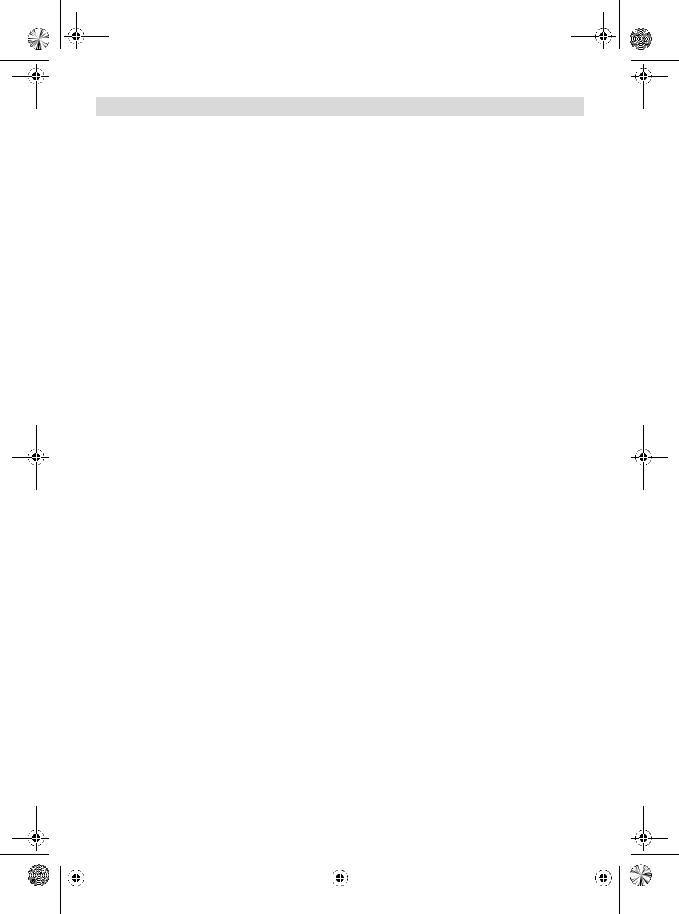
OBJ_BUCH-114-002.book Page 19 Tuesday, November 9, 2010 11:58 AM
Great Britain
Robert Bosch Ltd. (B.S.C.) P.O. Box 98
Broadwater Park
North Orbital Road Denham
Uxbridge
UB 9 5HJ
Tel. Service: +44 (0844) 736 0109 Fax: +44 (0844) 736 0146
E-Mail: boschservicecentre@bosch.com
Ireland
Origo Ltd.
Unit 23 Magna Drive
Magna Business Park
City West
Dublin 24
Tel. Service: +353 (01) 4 66 67 00
Fax: +353 (01) 4 66 68 88
Australia, New Zealand and Pacific Islands
Robert Bosch Australia Pty. Ltd. Power Tools
Locked Bag 66
Clayton South VIC 3169
Customer Contact Center Inside Australia:
Phone: +61 (01300) 307 044 Fax: +61 (01300) 307 045 Inside New Zealand:
Phone: +64 (0800) 543 353 Fax: +64 (0800) 428 570 Outside AU and NZ: Phone: +61 (03) 9541 5555 www.bosch.com.au
Republic of South Africa
Customer service
Hotline: +27 (011) 6 51 96 00
Gauteng – BSC Service Centre
35 Roper Street, New Centre Johannesburg
Tel.: +27 (011) 4 93 93 75 Fax: +27 (011) 4 93 01 26 E-Mail: bsctools@icon.co.za
English | 19
KZN – BSC Service Centre
Unit E, Almar Centre
143 Crompton Street Pinetown
Tel.: +27 (031) 7 01 21 20
Fax: +27 (031) 7 01 24 46 E-Mail: bsc.dur@za.bosch.com
Western Cape – BSC Service Centre
Democracy Way, Prosperity Park Milnerton
Tel.: +27 (021) 5 51 25 77
Fax: +27 (021) 5 51 32 23 E-Mail: bsc@zsd.co.za
Bosch Headquarters
Midrand, Gauteng
Tel.: +27 (011) 6 51 96 00
Fax: +27 (011) 6 51 98 80
E-Mail: rbsa-hq.pts@za.bosch.com
People’s Republic of China
China Mainland
Bosch Power Tools (China) Co., Ltd. 567, Bin Kang Road
Bin Jiang District 310052 Hangzhou, P.R.China
Service Hotline: 400 826 8484 Fax: +86 571 8777 4502
E-Mail: contact.ptcn@cn.bosch.com www.bosch-pt.com.cn
HK and Macau Special Administrative Regions
Robert Bosch Hong Kong Co. Ltd. 21st Floor, 625 King’s Road North Point, Hong Kong
Customer Service Hotline: +852 (21) 02 02 35 Fax: +852 (25) 90 97 62
E-Mail: info@hk.bosch.com www.bosch-pt.com.hk
Indonesia
PT. Multi Tehaka
Kawasan Industri Pulogadung
Jalan Rawa Gelam III No. 2
Jakarta 13930
Indonesia
Tel.: +62 (21) 46 83 25 22
Fax: +62 (21) 46 82 86 45/68 23
E-Mail: sales@multitehaka.co.id
www.multitehaka.co.id
|
|
Bosch Power Tools |
|
|
1 609 929 W83 | (9.11.10) |
|
|
||
|
|
|
|
|
|
|
|
|
|
|
|
|
|
|
|
|
|
|
|
|
|
|
|
|
|
|
|
|
|

 OBJ_BUCH-114-002.book Page 20 Tuesday, November 9, 2010 11:58 AM
OBJ_BUCH-114-002.book Page 20 Tuesday, November 9, 2010 11:58 AM
20 | English
Philippines
Robert Bosch, Inc.
28th Floor Fort Legend Towers, 3rd Avenue corner 31st Street, Fort Bonifacio Global City, 1634 Taguig City, Philippines Tel.: +63 (2) 870 3871
Fax: +63 (2) 870 3870 matheus.contiero@ph.bosch.com www.bosch-pt.com.ph
Bosch Service Center: 9725-27 Kamagong Street San Antonio Village Makati City, Philippines Tel.: +63 (2) 899 9091 Fax: +63 (2) 897 6432
rosalie.dagdagan@ph.bosch.com
Malaysia
Robert Bosch (S.E.A.) Pte. Ltd. No. 8A, Jalan 13/6
G.P.O. Box 10818
46200 Petaling Jaya
Selangor, Malaysia Tel.: +60 (3) 7966 3194 Fax: +60 (3) 7958 3838
cheehoe.on@my.bosch.com Toll-Free: 1800 880 188 www.bosch-pt.com.my
Thailand
Robert Bosch Ltd. Liberty Square Building No. 287, 11 Floor Silom Road, Bangrak Bangkok 10500
Tel.: +66 (2) 6 31 18 79 – 18 88 (10 lines) Fax: +66 (2) 2 38 47 83
Robert Bosch Ltd., P. O. Box 2054 Bangkok 10501, Thailand
Bosch Service – Training Centre 2869-2869/1 Soi Ban Kluay
Rama IV Road (near old Paknam Railway) Prakanong District
10110 Bangkok Thailand
Tel.: +66 (2) 6 71 78 00 – 4 Fax: +66 (2) 2 49 42 96 Fax: +66 (2) 2 49 52 99
Singapore
Robert Bosch (SEA) Pte. Ltd. 11 Bishan Street 21 Singapore 573943
Tel.: +65 6571 2772
Fax: +65 6350 5315 leongheng.leow@sg.bosch.com Toll-Free: 1800 333 8333 www.bosch-pt.com.sg
Vietnam
Robert Bosch Vietnam Co. Ltd 10/F, 194 Golden Building 473 Dien Bien Phu Street Ward 25, Binh Thanh District 84 Ho Chi Minh City
Vietnam
Tel.: +84 (8) 6258 3690 ext. 413 Fax: +84 (8) 6258 3692 hieu.lagia@vn.bosch.com www.bosch-pt.com
Further informations on diamond drilling can be found under www.bosch-diamond.com.
Disposal
The machine, accessories and packaging should be sorted for environmental-friendly recycling.
Do not dispose of power tools into household waste!
Only for EC countries:
According to the European Guideline 2002/96/EC for Waste Electrical and Electronic Equipment and its implementation into national right, power tools that are no longer usable must be collected separately and disposed of in an environmentally correct manner.
Subject to change without notice.
|
|
1 609 929 W83 | (9.11.10) |
|
|
Bosch Power Tools |
|
|
||
|
|
|
|
|
|
|
|
|
|
|
|
|
|
|
|
|
|
|
|
|
|
|
|
|
|
|
|
|
|
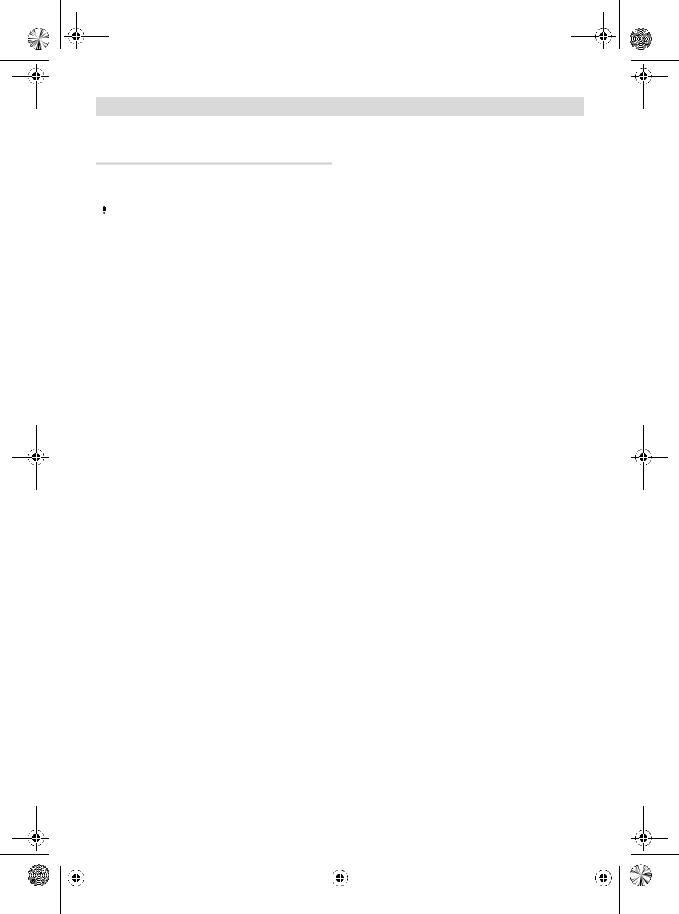
OBJ_BUCH-114-002.book Page 21 Tuesday, November 9, 2010 11:58 AM
Avertissements de sécurité
Avertissements de sécurité généraux pour l’outil
|
Lors de l’utilisation d’outil |
ATTENTION |
|
|
électroportatifs, respecter les |
instructions de sécurité fondamentales suivantes afin d’éviter les risques de choc électrique, de blessures et d’incendie.
Lire toutes les consignes avant d’utiliser cet outil électroportatif et garder soigneusement les consignes de sécurité.
Le terme « outil » dans les consignes de sécurité fait référence à votre outil électrique alimenté par le secteur (avec cordon d’alimentation) ou votre outil fonctionnant sur batterie (sans cordon d’alimentation).
1)Sécurité de la zone de travail
a)Conserver la zone de travail propre et bien éclairée. Les zones en désordre ou sombres sont propices aux accidents.
b)Ne pas faire fonctionner les outils électriques en atmosphère explosive, par exemple en présence de liquides inflammables, de gaz ou de poussières. Les outils électriques produisent des étincelles qui peuvent enflammer les poussières ou les fumées.
c)Maintenir les enfants et les personnes présentes à l’écart pendant l’utilisation de l’outil. Les distractions peuvent vous faire perdre le contrôle de l’outil.
2)Sécurité électrique
a)Il faut que les fiches de l’outil électrique soient adaptées au socle. Ne jamais modifier la fiche de quelque façon que ce soit. Ne pas utiliser d’adaptateurs avec des outils à branchement de terre. Des fiches non modifiées et des socles adaptés réduiront le risque de choc électrique.
b)Eviter tout contact du corps avec des surfaces reliées à la terre telles que les tuyaux, les radiateurs, les cuisinières et les réfrigérateurs. Il existe un risque accru de choc électrique si votre corps est relié à la terre.
Français | 21
c)Ne pas exposer les outils à la pluie ou à des conditions humides. La pénétration d’eau à l’intérieur d’un outil augmentera le risque de choc électrique.
d)Ne pas maltraiter le cordon. Ne jamais utiliser le cordon pour porter, tirer ou débrancher l’outil. Maintenir le cordon à l’écart de la chaleur, du lubrifiant, des arêtes ou des parties en mouvement. Les cordons endommagés ou emmêlés augmentent le risque de choc électrique.
e)Lorsqu’on utilise un outil à l’extérieur, utiliser un prolongateur adapté à l’utilisation extérieure. L’utilisation d’un cordon adapté à l’utilisation extérieure réduit le risque de choc électrique.
3)Sécurité des personnes
a)Rester vigilant, regarder ce que vous êtes en train de faire et faire preuve de bon sens dans l’utilisation de l’outil. Ne pas utiliser un outil lorsque vous êtes fatigué ou sous l’emprise de drogues, d’alcool ou de médicaments. Un moment d’inattention en cours d’utilisation d’un outil peut entraîner des blessures graves des personnes.
b)Utiliser un équipement de sécurité. Toujours porter une protection pour les yeux.
Les équipements de sécurité tels que les masques contre les poussières, les chaussures de sécurité antidérapantes, les casques ou les protections acoustiques utilisés pour les conditions appropriées réduiront les blessures des personnes.
c)Eviter tout démarrage intempestif. S’assurer que l’interrupteur est en position arrêt avant de brancher l’outil au secteur et/ou au bloc de batteries, de le ramasser ou de le porter. Porter les outils en ayant le doigt sur l’interrupteur ou brancher des outils dont l’interrupteur est en position marche est source d’accidents.
d)Retirer toute clé de réglage avant de mettre l’outil en marche. Une clé laissée fixée sur une partie tournante de l’outil peut donner lieu à des blessures de personnes.
|
|
Bosch Power Tools |
|
|
1 609 929 W83 | (9.11.10) |
|
|
||
|
|
|
|
|
|
|
|
|
|
|
|
|
|
|
|
|
|
|
|
|
|
|
|
|
|
|
|
|
|
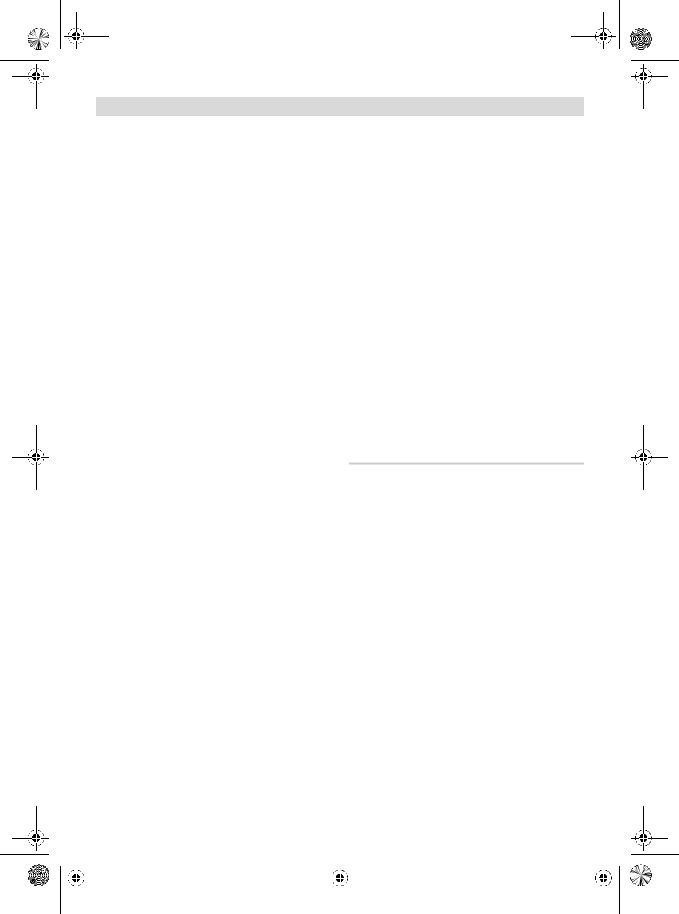
OBJ_BUCH-114-002.book Page 22 Tuesday, November 9, 2010 11:58 AM
22 | Français
e)Ne pas se précipiter. Garder une position et un équilibre adaptés à tout moment. Cela permet un meilleur contrôle de l’outil dans des situations inattendues.
f)S’habiller de manière adaptée. Ne pas porter de vêtements amples ou de bijoux. Garder les cheveux, les vêtements et les gants à distance des parties en mouvement. Des vêtements amples, des bijoux ou les cheveux longs peuvent être pris dans des parties en mouvement.
g)Si des dispositifs sont fournis pour le raccordement d’équipements pour l’extraction et la récupération des poussières, s’assurer qu’ils sont connectés et correctement utilisés. Utiliser des collecteurs de poussière peut réduire les risques dus aux poussières.
4)Utilisation et entretien de l’outil
a)Ne pas forcer l’outil. Utiliser l’outil adapté à votre application. L’outil adapté réalisera mieux le travail et de manière plus sûre au régime pour lequel il a été construit.
b)Ne pas utiliser l’outil si l’interrupteur ne permet pas de passer de l’état de marche à arrêt et vice versa. Tout outil qui ne peut pas être commandé par l’interrupteur est dangereux et il faut le faire réparer.
c)Débrancher la fiche de la source d’alimentation en courant et/ou le bloc de batteries de l’outil avant tout réglage, changement d’accessoires ou avant de ranger l’outil. De telles mesures de sécurité préventives réduisent le risque de démarrage accidentel de l’outil.
d)Conserver les outils à l’arrêt hors de la portée des enfants et ne pas permettre à des personnes ne connaissant pas l’outil ou les présentes instructions de le faire fonctionner. Les outils sont dangereux entre les mains d’utilisateurs novices.
e)Observer la maintenance de l’outil. Vérifier qu’il n’y a pas de mauvais alignement ou de blocage des parties mobiles, des pièces cassées ou toute autre condition pouvant affecter le fonctionnement de
l’outil. En cas de dommages, faire réparer l’outil avant de l’utiliser. De nombreux accidents sont dus à des outils mal entretenus.
f)Garder affûtés et propres les outils permettant de couper. Des outils destinés à couper correctement entretenus avec des pièces coupantes tranchantes sont moins susceptibles de bloquer et sont plus faciles à contrôler.
g)Utiliser l’outil, les accessoires et les lames etc., conformément à ces instructions, en tenant compte des conditions de travail et du travail à réaliser. L’utilisation de l’outil pour des opérations différentes de celles prévues pourrait donner lieu à des situations dangereuses.
5)Maintenance et entretien
a)Faire entretenir l’outil par un réparateur qualifié utilisant uniquement des pièces de rechange identiques. Cela assurera que la sécurité de l’outil est maintenue.
Avertissements de sécurité pour les appareils de forage diamant
fTenir l’outil électrique uniquement par les surfaces de préhension isolantes du support de forage, pendant les opérations au cours desquelles l’accessoire coupant peut être en contact avec des conducteurs cachés ou avec son propre câble. Le contact de l’accessoire coupant avec un fil sous tension peut également mettre sous tension les parties métalliques visibles de l’outil électrique et entraîner l’électrocution de l’opérateur.
fUtiliser des détecteurs appropriés afin de déceler des conduites cachées ou consulter les entreprises d’approvisionnement locales. Un contact avec des lignes électriques peut provoquer un incendie ou un choc électrique. Un endommagement d’une conduite de gaz peut provoquer une explosion. La perforation d’une conduite d’eau provoque des dégâts matériels et peut provoquer un choc électrique.
|
|
1 609 929 W83 | (9.11.10) |
|
|
Bosch Power Tools |
|
|
||
|
|
|
|
|
|
|
|
|
|
|
|
|
|
|
|
|
|
|
|
|
|
|
|
|
|
|
|
|
|
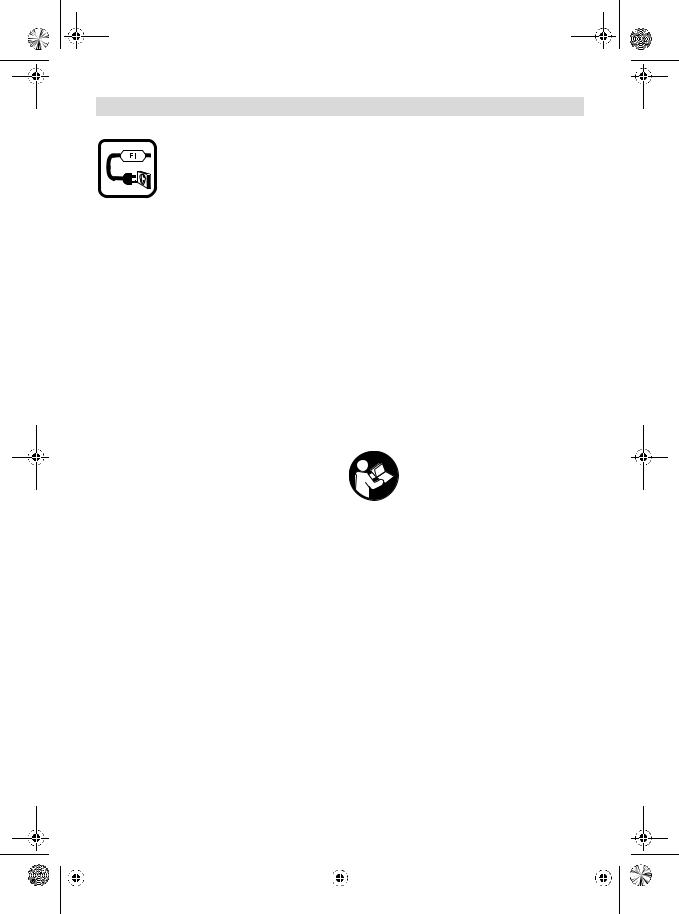
OBJ_BUCH-114-002.book Page 23 Tuesday, November 9, 2010 11:58 AM
Ne jamais utiliser l’outil électroportatif sans le disjoncteur différentiel fourni avec.
fContrôler le bon fonctionnement du disjoncteur différentiel avant de commencer le travail. Faire réparer ou remplacer les disjoncteurs différentiels auprès d’un atelier de service après-vente Bosch.
fVeiller à ce que ni les personnes se trouvant dans la zone de travail ni l’outil électroportatif n’entre en contact avec l’eau qui déborde.
fVeiller à ce que les tuyaux contenant de l’eau, les éléments de raccord ainsi que le collecteur d’eau (accessoire) soit dans un état impeccable. Remplacer les parties endommagées ou usées avant l’utilisation suivante. Le fait que de l’eau déborde des parties de l’outil électroportatif, augmente le risque d’un choc électrique.
fEn cas de non-utilisation, conservez l’outil électrique dans un endroit sûr. L’emplacement de stockage doit être sec et verrouillable. Ceci prévient l’endommagement de l’outil électrique pendant le stockage ou son utilisation par des personnes non initiées.
fGarder les poignées sèches, propres et dépourvues d’huile et de graisse. Des poignées grasses, huileuses sont glissantes et provoquent ainsi une perte de contrôle.
fNe jamais utiliser un outil électroportatif dont le câble est endommagé. Ne pas toucher à un câble endommagé et retirer la fiche du câble d’alimentation de la prise de courant, au cas où le câble aurait été endommagé lors du travail. Un câble endommagé augmente le risque de choc électrique.
fContrôler le câble régulièrement et ne faire réparer un câble endommagé que par un Service Après-Vente autorisé pour outillage électroportatifs Bosch. Remplacer un câble de rallonge endommagé. Ceci est indispensable pour assurer le bon fonctionnement en toute sécurité de l’outil électrique.
Français | 23
fPorter des chaussures à semelle antidérapante. Ceci permet d’éviter des blessures causées par le fait de glisser sur des surfaces lisses.
fN’utiliser que des accessoires d’origine Bosch.
fRespecter scrupuleusement les instructions de sécurité ainsi que les indications de travail du support de forage utilisé et des accessoires utilisés !
fNe jamais quitter l’outil avant son arrêt total.
Les outils de travail qui ne sont pas encore en arrêt total peuvent causer des blessures.
fBrancher l’outil électroportatif sur le réseau de courant électrique correctement relié à la terre. La prise de courant ainsi que la rallonge électrique doivent être munies d’un conducteur de protection en bon état.
Description du fonctionnement
Il est impératif de lire toutes les consignes de sécurité et toutes les
instructions. Le non-respect des
avertissements et instructions indiqués ci-après peut conduire à une électrocution, un incendie et/ou de graves blessures.
Dépliez le volet sur lequel l’appareil est représenté de manière graphique. Laissez le volet déplié pendant la lecture de la présente notice d’utilisation.
|
|
Bosch Power Tools |
|
|
1 609 929 W83 | (9.11.10) |
|
|
||
|
|
|
|
|
|
|
|
|
|
|
|
|
|
|
|
|
|
|
|
|
|
|
|
|
|
|
|
|
|
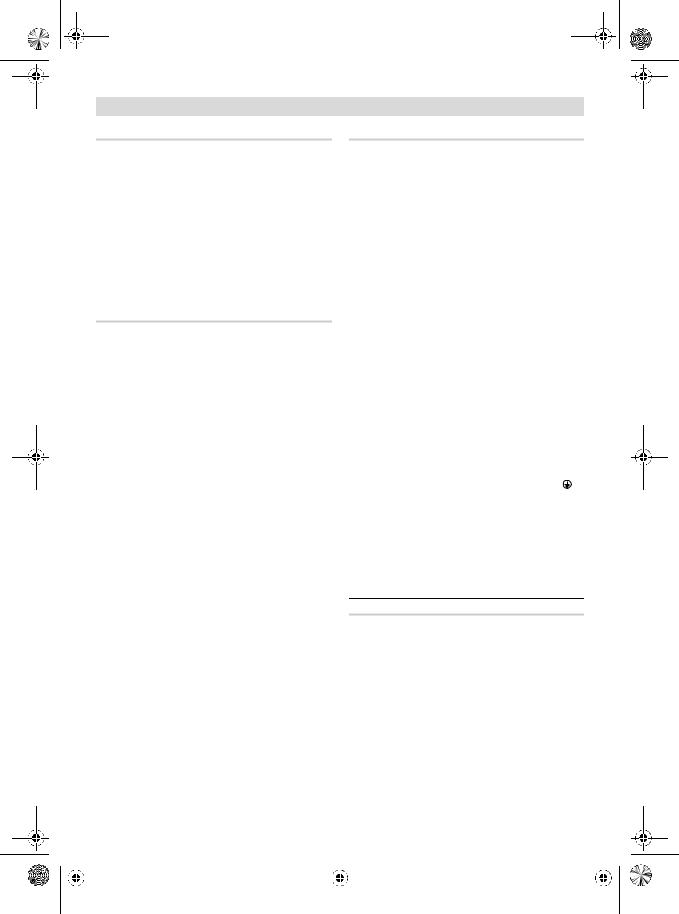
OBJ_BUCH-114-002.book Page 24 Tuesday, November 9, 2010 11:58 AM
24 | Français
Utilisation conforme
L’appareil électroportatif, en combinaison avec des couronnes diamantées de forage à eau et avec une alimentation en eau, est conçu pour le forage à eau dans les matériaux composés de minéraux tels que le béton, le béton armé et la maçonnerie. Il n’est pas conçu pour les travaux de forage au-dessus de la tête. L’appareil électroportatif ne doit être utilisé qu’avec le support de forage S 500 A. Il est possible de combiner l’appareil électroportatif avec un dispositif d’aspiration (collecteur d’eau et aspirateur universel).
Eléments de l’appareil
La numérotation des éléments de l’appareil se réfère à la représentation de l’outil électroportatif sur la page graphique.
1Support de forage diamanté S 500 A*
2Disjoncteur différentiel
3Raccord d’arrivé d’eau
4Commutateur de vitesse
5Manivelle d’avance (S 500 A)
6Collecteur d’eau*
7Couronne de forage*
8Rondelle*
9Broche d’entraînement
10Affichage du débit d’eau
11Robinet d’arrêt d’eau
12Lampe-témoin
13Interrupteur Marche/Arrêt
14Surfaces de prise isolées
*Les accessoires décrits ou illustrés ne sont pas tous compris dans la fourniture. Vous trouverez les accessoires complets dans notre programme d’accessoires.
Caractéristiques techniques
Appareil de forage diamant |
GDB 2500 WE |
|
|
|
Professional |
N° d’article |
|
0 601 18P 7.. |
Puissance nominale |
|
|
absorbée |
W |
2500 |
Puissance utile débi- |
|
|
tée |
W |
1450 |
Vitesse de rotation |
|
|
nominale n0 |
|
|
– 1ère vitesse |
tr/min |
440 |
– 2ème vitesse |
tr/min |
960 |
Diamètre de l’alésage |
|
|
– plage optimale |
mm |
82–132 |
– plage possible |
mm |
32–212 |
Porte-outil |
|
1 1/4" UNC, |
|
|
G 1/2" |
Pression max. ali- |
|
|
mentation en eau |
bar |
6 |
Poids suivant EPTA- |
|
|
Procedure 01/2003 |
kg |
11,8 |
Classe de protection |
|
/I |
|
|
|
Ces indications sont valables pour une tension nominale de [U] 230 V. Ces indications peuvent varier pour des tensions plus basses ainsi que pour des versions spécifiques à certains pays.
Respectez impérativement le numéro d’article se trouvant sur la plaque signalétique de l’outil électroportatif. Les désignations commerciales des différents outils électroportatifs peuvent varier.
Niveau sonore et vibrations
Valeurs de mesure du niveau sonore déterminées conformément à la norme EN 61029.
Les mesures réelles (A) des niveaux sonores de l’appareil sont : niveau de pression acoustique 89 dB(A) ; niveau d’intensité acoustique
100 dB(A). Incertitude K= 3 dB.
Porter une protection acoustique !
Valeurs totales des vibrations (somme vectorielle des trois axes directionnels) relevées conformément à la norme EN 61029 :
Valeur d’émission vibratoire ah = 3 m/s2, incertitude K = 1,5 m/s2.
|
|
1 609 929 W83 | (9.11.10) |
|
|
Bosch Power Tools |
|
|
||
|
|
|
|
|
|
|
|
|
|
|
|
|
|
|
|
|
|
|
|
|
|
|
|
|
|
|
|
|
|
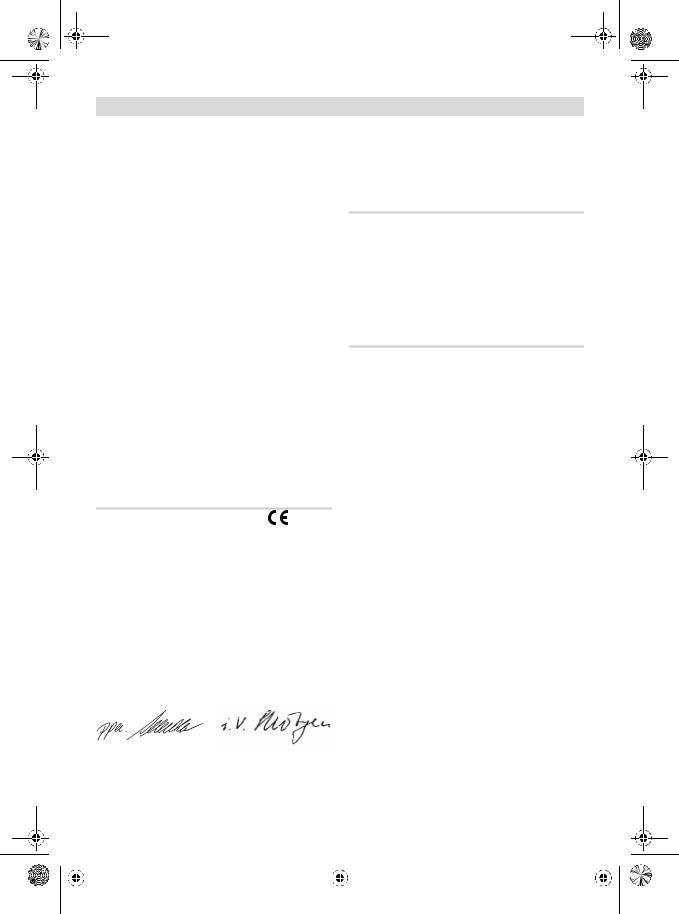
OBJ_BUCH-114-002.book Page 25 Tuesday, November 9, 2010 11:58 AM
Le niveau d’oscillation indiqué dans ces instructions d’utilisation a été mesuré conformément à la norme EN 61029 et peut être utilisé pour une comparaison d’outils électroportatifs. Il est également approprié pour une estimation préliminaire de la charge vibratoire.
Le niveau d’oscillation correspond aux utilisations principales de l’outil électroportatif. Si l’outil électrique est cependant utilisé pour d’autres applications, avec d’autres outils de travail ou avec un entretien non approprié, le niveau d’oscillation peut être différent. Ceci peut augmenter considérablement la charge vibratoire pendant toute la durée de travail.
Pour une estimation précise de la charge vibratoire, il est recommandé de prendre aussi en considération les périodes pendant lesquelles l’appareil est éteint ou en fonctionnement, mais pas vraiment utilisé. Ceci peut réduire considérablement la charge vibratoire pendant toute la durée de travail.
Déterminez des mesures de protection supplémentaires pour protéger l’utilisateur des effets des vibrations, telles que par exemple : Entretien de l’outil électrique et des outils de travail, maintenir les mains chaudes, organisation des opérations de travail.
Déclaration de conformité
Nous déclarons sous notre propre responsabilité que le produit décrit sous « Caractéristiques techniques » est en conformité avec les normes ou documents normatifs suivants : EN 61029 conformément aux termes des réglementations 2004/108/CE, 2006/42/CE.
Dossier technique auprès de : Robert Bosch GmbH, PT/ESC, D-70745 Leinfelden-Echterdingen
Dr. Egbert Schneider |
Dr. Eckerhard Strötgen |
Senior Vice President |
Head of Product |
Engineering |
Certification |
Robert Bosch GmbH, Power Tools Division
D-70745 Leinfelden-Echterdingen
Leinfelden, 05.10.2010
Français | 25
Montage
fAvant d’effectuer des travaux sur l’outil électroportatif, retirez la fiche de la prise de courant.
Serrage dans le support de forage diamanté S 500 A
fRespectez scrupuleusement les instructions de sécurité ainsi que les indications d’utilisation du support de forage !
Pour monter l’outil électroportatif sur le support de forage, lisez et suivez les instructions d’utilisation de ce dernier.
Montage/Changement de la couronne
fAvant tout travail effectué sur l’outil électroportatif, lors des pauses de travail ainsi qu’en cas de non-utilisation, bloquez l’outil électroportatif sur son support de forage en verrouillant le blocage d’avance pour éviter ainsi un mouvement non-intentionné. Lisez et suivez les instructions d’utilisation du support de forage.
Monter la couronne de forage
fContrôlez les couronnes de forage avant de les monter. Ne montez que des couronnes de forage en parfait état. Les couronnes de forage endommagées ou déformées peuvent entraîner des situations dangereuses.
Nettoyez la couronne de forage avant de la monter. Graissez légèrement le filetage de la couronne de forage ou vaporisez-le d’une protection anti-corrosion.
Vissez soit une couronne de forage G 1/2" sur la broche d’entraînement 9 ou une couronne de forage 1 1/4"-UNC sur la broche d’entraînement 9.
fContrôlez si la couronne de forage est bien serrée. Les couronnes de forage pas correctement fixées peuvent se détacher pendant l’utilisation et vous mettre en danger.
Le fait de placer un anneau de glissement 8 (accessoire) entre la broche d’entraînement et la couronne de forage 1 1/4"-UNC facilite un desserrage ultérieur de la couronne.
|
|
Bosch Power Tools |
|
|
1 609 929 W83 | (9.11.10) |
|
|
||
|
|
|
|
|
|
|
|
|
|
|
|
|
|
|
|
|
|
|
|
|
|
|
|
|
|
|
|
|
|
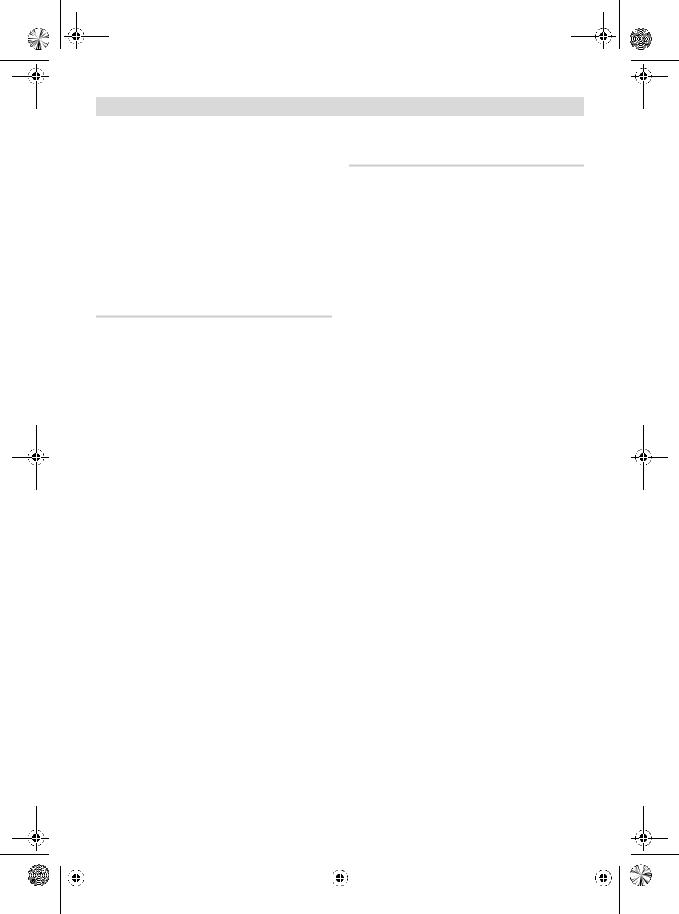
OBJ_BUCH-114-002.book Page 26 Tuesday, November 9, 2010 11:58 AM
26 | Français
Retirer la couronne de forage
fPortez des gants de protection pour remplacer la couronne de forage. Dans le cas d’utilisation prolongée de l’outil électroportatif, la couronne de forage peut se chauffer.
Desserrez la couronne de forage 7 à l’aide d’une clé plate (couronne de forage 1 1/4"-UNC : ouverture 41 mm ; couronne de forage G 1/2" : ouverture 22 mm). Pour ce faire, bloquez le deux-pans de la broche d’entraînement 9 à l’aide d’une deuxième clé plate (ouverture
36 mm).
Raccordement d’un refroidissement à eau
Si les couronnes de forage à eau ne sont pas suffisamment refroidies pendant le perçage, les segments diamantés peuvent être endommagés ou la couronne peut se coincer dans l’alésage. Veillez donc à assurer un alimentation en eau suffisante lors des travaux de perçage à eau.
Lorsqu’un alésage existant est élargi, fermez bien cet alésage pour permettre un refroidissement suffisant de la couronne de forage.
fLes tuyaux raccordés, les vannes d’arrêt ou les accessoires ne doivent pas entraver l’opération de perçage.
Fermez le robinet d’arrêt d’eau 11. Raccordez une conduite d’amenée d’eau sur le raccord d’arrivée d’eau 3. Il est possible d’amener de l’eau à partir d’un réservoir mobile d’eau sous pression (accessoire) ou à partir d’un raccord de robinet stationnaire.
Pour recueillir l’eau sortante du forage lors d’un perçage à arrosage, un collecteur d’eau et un aspirateur universel (tous les deux accessoires) sont nécessaires.
Pour le montage du collecteur d’eau, lisez et suivez les instructions d’utilisation de ce dernier.
Mise en marche
Mise en service
fTenez compte de la tension du réseau ! La tension de la source de courant doit correspondre aux indications se trouvant sur la plaque signalétique de l’outil électroportatif. Les outils électroportatifs marqués 230 V peuvent également fonctionner sur 220 V.
fAvant de commencer le travail, consultez l’ingénieur du génie civile, l’architecte compétent ou la direction responsable des travaux pour vous renseigner sur le perçage prévu. Ne séparez les armatures qu’avec autorisation d’un ingénieur du génie civile.
fDans le cas de perçages traversant les murs ou le sol, contrôlez impérativement s’il existe des obstacles dans les locaux concernés. Barrez l’accès au chantier et, à l’aide d’une protection circulaire, veillez à ce que la carotte ne tombe pas.
Test de fonctionnement du disjoncteur différentiel
Contrôlez le bon fonctionnement du disjoncteur différentiel 2 avant de commencer le travail.
–Appuyez sur la touche « RESET » se trouvant sur le disjoncteur différentiel. Une lampe-té- moin rouge indique que le disjoncteur différentiel est en service.
–Appuyez sur la touche « TEST ». L’affichage au-dessus de la touche « RESET » devient noir.
Mise en marche
Appuyez sur la touche « RESET » se trouvant sur le disjoncteur différentiel.2
Mettez le robinet d’arrêt d’eau 11 sur débit. Auprès de l’affichage du débit 10, contrôlez le débit d’eau.
Pour commencer le forage avec demi-vitesse, mettez l’interrupteur Marche/Arrêt 13 dans la position 1/2. Dans cette position, il n’est pas possible de bloquer l’interrupteur.
Pour percer, mettez l’interrupteur Marche/Arrêt 13 dans la position I.
|
|
1 609 929 W83 | (9.11.10) |
|
|
Bosch Power Tools |
|
|
||
|
|
|
|
|
|
|
|
|
|
|
|
|
|
|
|
|
|
|
|
|
|
|
|
|
|
|
|
|
|

OBJ_BUCH-114-002.book Page 27 Tuesday, November 9, 2010 12:31 PM
Arrêt
Relâchez l’interrupteur Marche/Arrêt 13 ou tour- nez-le pour le mettre dans la position 0.
Fermez le robinet d’arrêt d’eau 11. Une fois l’opération de travail terminé, déconnectez le robinet d’arrivé d’eau 3 de la conduite d’amenée d’eau. Ouvrez le robinet d’arrêt d’eau 11 et laissez couler l’eau restante.
Réglage de la vitesse de rotation
Le commutateur de vitesse 4 permet de présélectionner deux plages de vitesse de rotation.
Les deux vitesses sont recommandées pour les diamètres de perçage suivants :
1ère vitesse |
82–212 mm |
2ème vitesse |
32–132 mm |
Instructions d’utilisation
fAvant d’effectuer des travaux sur l’outil électroportatif, retirez la fiche de la prise de courant.
Pour le forage, desserrez le blocage de la manivelle d’avance 5 (voir instructions d’utilisation du support de forage).
Commencez le forage avec demi-vitesse de rotation (interrupteur Marche/Arrêt en position 1/2, jusqu’à ce que la couronne tourne sans vibrations dans le matériau. Continuez à forer avec vitesse de rotation maximale (interrupteur Marche/Arrêt en position I).
Adaptez la pression exercée lors du forage au matériau à travailler. Percez en exerçant une pression régulière. De temps en temps, retirez la couronne de forage légèrement du trou foré pour que la boue puisse être enlevée des segments diamantés.
Ne sollicitez pas trop l’outil électroportatif. En cas de surcharge, la lampe-témoin clignote 12 (voir « Lampe-témoin »).
Accouplement de surcharge
Dès que la couronne de forage se coince ou qu’elle s’accroche, l’entraînement de la broche est interrompu. Dans un tel cas, arrêtez l’outil électroportatif et enlevez la couronne de forage.
Français | 27
Lampe-témoin
La lampe-témoin 12 clignote :
L’outil électroportatif tra-
vaille en surcharge.
Réduisez la pression appli-
quée. Le cas échéant, arrêtez
l’outil électroportatif et affûtez la couronne de forage.
Si la pression appliquée n’est pas réduite, l’électronique réduit la vitesse de rotation, le cas échéant jusqu’à l’arrêt de l’appareil. Une fois la sollicitation réduite, l’outil électroportatif se remet automatiquement en fonction.
La lampe-témoin 12 est constamment allumée :
Les balais doivent être rem-
placés.
Un atelier de Service AprèsVente Bosch autorisé effectue ce travail rapidement et de façon fiable.
Retirer la carotte
Après le perçage, laissez l’eau couler encore un peu afin de rincer la boue entre la couronne de forage et la carotte.
Si la carotte est coincée dans la couronne de forage, au moyen d’une pièce de bois tendre ou d’une pièce en matière plastique, frappez sur la couronne de forage et desserrez ainsi la carotte. Le cas échéant, poussez une tige à travers la queue de la couronne pour ressortir la carotte.
Note : Ne frappez pas avec des objets durs sur la couronne de forage (danger de déformation) !
|
|
Bosch Power Tools |
|
|
1 609 929 W83 | (9.11.10) |
|
|
||
|
|
|
|
|
|
|
|
|
|
|
|
|
|
|
|
|
|
|
|
|
|
|
|
|
|
|
|
|
|
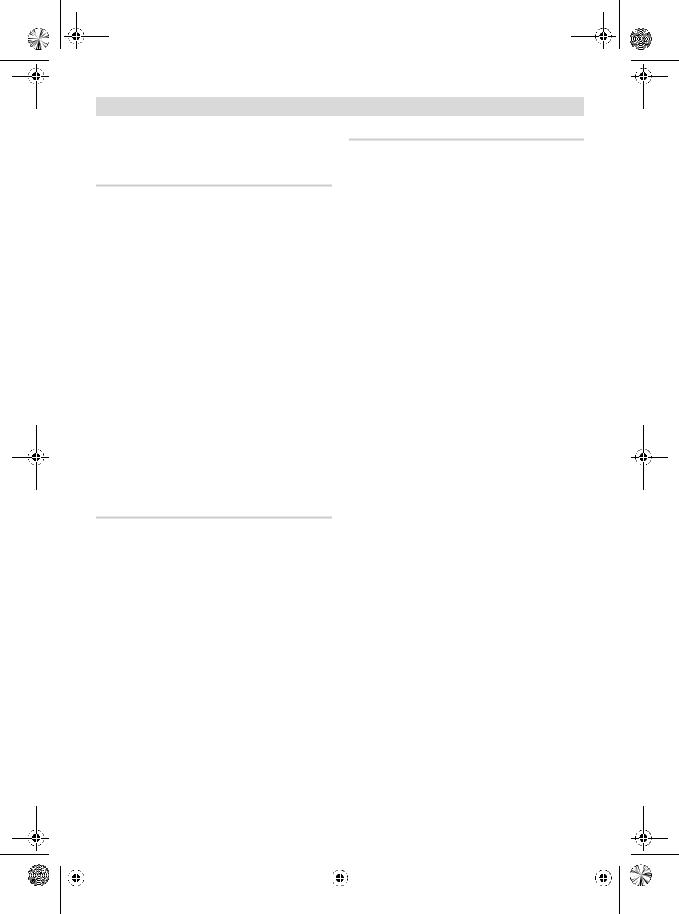
OBJ_BUCH-114-002.book Page 28 Tuesday, November 9, 2010 11:58 AM
28 | Français
Entretien et Service
Après-Vente
Nettoyage et entretien
fAvant d’effectuer des travaux sur l’outil électroportatif, retirez la fiche de la prise de courant.
fVeillez à ce que l’outil électroportatif ainsi que les ouïes de ventilation soient toujours propres afin d’obtenir un travail impeccable et sûr.
Une fois l’opération terminée, nettoyez la broche d’entraînement 9. De temps en temps, aspergez la broche d’entraînement et la couronne de forage 7 avec un produit anti-corrosion.
Si, malgré tous les soins apportés à la fabrication et au contrôle de l’appareil, celui-ci présentait un défaut, la réparation ne doit être confiée qu’à une station de Service Après-Vente agréée pour outillage Bosch.
Pour toute demande de renseignement ou commande de pièces de rechange, précisez-nous impérativement le numéro d’article à dix chiffres de l’outil électroportatif indiqué sur la plaque signalétique.
Accessoires/pièces de rechange
Support de forage diamanté
S 500 A . . . . . . . . . . . . . . . . . . . 0 601 190 025 Collecteur d’eau . . . . . . . . . . . . 2 609 390 389
Joint d’étanchéité pour
collecteur d’eau . . . . . . . . . . . . . 2 609 390 391 Réservoir d’eau sous pression . . 2 609 390 308 Rondelle . . . . . . . . . . . . . . . . . . 1 600 190 042 Rallonge 300 mm :
–pour couronne de forage
G 1/2" . . . . . . . . . . . . . . . . . . 2 608 598 044
–pour couronne de forage
1 1/4" UNC . . . . . . . . . . . . . . 2 608 598 045
Service Après-Vente et Assistance Des Clients
Notre Service Après-Vente répond à vos questions concernant la réparation et l’entretien de votre produit et les pièces de rechange. Vous trouverez des vues éclatées ainsi que des informations concernant les pièces de rechange également sous :
www.bosch-pt.com
Les conseillers techniques Bosch sont à votre disposition pour répondre à vos questions concernant l’achat, l’utilisation et le réglage de vos produits et de leurs accessoires.
France
Vous êtes un utilisateur, contactez :
Le Service Clientèle Bosch Outillage Electroportatif
Tel. : 0 811 36 01 22
(coût d’une communication locale) Fax : +33 (0) 1 49 45 47 67
E-Mail : contact.outillage-electroportatif@fr.bosch.com
Vous êtes un revendeur, contactez : Robert Bosch (France) S.A.S. Service Après-Vente Electroportatif 126, rue de Stalingrad
93705 DRANCY Cédex
Tel. : +33 (0) 1 43 11 90 06
Fax : +33 (0) 1 43 11 90 33 E-Mail :
sav.outillage-electroportatif@fr.bosch.com
Belgique, Luxembourg
Tel. : +32 (070) 22 55 65
Fax : +32 (070) 22 55 75
E-Mail : outillage.gereedschap@be.bosch.com
Suisse
Tel. : +41 (044) 8 47 15 12
Fax : +41 (044) 8 47 15 52
Autres pays
Pour avoir des renseignements concernant la garantie, les travaux d’entretien ou de réparation ou les pièces de rechange, veuillez contacter votre détaillant spécialisé.
|
|
1 609 929 W83 | (9.11.10) |
|
|
Bosch Power Tools |
|
|
||
|
|
|
|
|
|
|
|
|
|
|
|
|
|
|
|
|
|
|
|
|
|
|
|
|
|
|
|
|
|
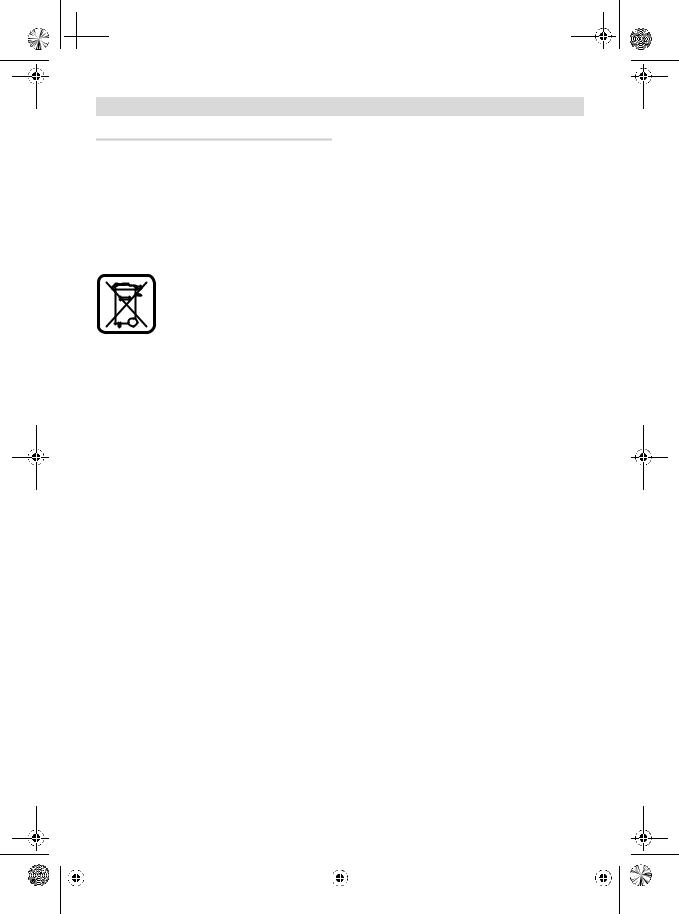
 OBJ_BUCH-114-002.book Page 29 Tuesday, November 9, 2010 11:58 AM
OBJ_BUCH-114-002.book Page 29 Tuesday, November 9, 2010 11:58 AM
Français | 29
Elimination des déchets
Les outils électroportatifs, ainsi que leurs accessoires et emballages, doivent pouvoir suivre chacun une voie de recyclage appropriée.
Ne jetez pas les outils électroportatifs avec les ordures ménagères !
Seulement pour les pays de l’Union Européenne :
Conformément à la directive européenne 2002/96/CE relative aux
déchets d’équipements électriques et électroniques et sa mise
en vigueur conformément aux législations nationales, les outils
électroportatifs dont on ne peut plus se servir doivent être isolés et suivre une voie de recyclage appropriée.
Sous réserve de modifications.
|
|
Bosch Power Tools |
|
|
1 609 929 W83 | (9.11.10) |
|
|
||
|
|
|
|
|
|
|
|
|
|
|
|
|
|
|
|
|
|
|
|
|
|
|
|
|
|
|
|
|
|

OBJ_BUCH-114-002.book Page 30 Tuesday, November 9, 2010 11:58 AM
30 | Español
Instrucciones de seguridad
Advertencias de peligro generales para herramientas eléctricas
ATENCIÓN Al utilizar herramientas eléctricas atenerse siempre a las si-
guientes medidas de seguridad básicas para reducir el riesgo de una descarga eléctrica, lesión e incendio.
Lea íntegramente estas instrucciones de seguridad antes de utilizar esta herramienta eléctrica y guárdelas en un lugar seguro.
El término “herramienta eléctrica” empleado en las siguientes instrucciones de seguridad se refiere a herramientas eléctricas de conexión a la red (con cable de red) y a herramientas eléctricas accionadas por acumulador (o sea, sin cable de red).
1)Seguridad del puesto de trabajo
a)Mantenga limpio y bien iluminado su puesto de trabajo. El desorden o una iluminación deficiente en las áreas de trabajo pueden provocar accidentes.
b)No utilice la herramienta eléctrica en un entorno con peligro de explosión, en el que se encuentren combustibles líquidos, gases o material en polvo. Las herramientas eléctricas producen chispas que pueden llegar a inflamar los materiales en polvo o vapores.
c)Mantenga alejados a los niños y otras personas de su puesto de trabajo al emplear la herramienta eléctrica. Una distracción le puede hacer perder el control sobre la herramienta eléctrica.
2)Seguridad eléctrica
a)El enchufe de la herramienta eléctrica debe corresponder a la toma de corriente utilizada. No es admisible modificar el enchufe en forma alguna. No emplear adaptadores en herramientas eléctricas dotadas con una toma de tierra. Los enchufes sin modificar adecuados a las respectivas tomas de corriente reducen el riesgo de una descarga eléctrica.
b)Evite que su cuerpo toque partes conectadas a tierra como tuberías, radiadores, cocinas y refrigeradores. El riesgo a quedar expuesto a una sacudida eléctrica es mayor si su cuerpo tiene contacto con tierra.
c)No exponga la herramienta eléctrica a la lluvia y evite que penetren líquidos en su interior. Existe el peligro de recibir una descarga eléctrica si penetran ciertos líquidos en la herramienta eléctrica.
d)No utilice el cable de red para transportar o colgar la herramienta eléctrica, ni tire de él para sacar el enchufe de la toma de corriente. Mantenga el cable de red alejado del calor, aceite, esquinas cortantes o piezas móviles. Los cables de red dañados o enredados pueden provocar una descarga eléctrica.
e)Al trabajar con la herramienta eléctrica a la intemperie utilice solamente cables de prolongación apropiados para su uso en exteriores. La utilización de un cable de prolongación adecuado para su uso en exteriores reduce el riesgo de una descarga eléctrica.
3)Seguridad de personas
a)Esté atento a lo que hace y emplee la herramienta eléctrica con prudencia. No utilice la herramienta eléctrica si estuviese cansado, ni tampoco después de haber consumido alcohol, drogas o medicamentos. El no estar atento durante el uso de la herramienta eléctrica puede provocarle serias lesiones.
b)Utilice un equipo de protección personal y en todo caso unas gafas de protección.
El riesgo a lesionarse se reduce considerablemente si, dependiendo del tipo y la aplicación de la herramienta eléctrica empleada, se utiliza un equipo de protección adecuado como una mascarilla antipolvo, zapatos de seguridad con suela antideslizante, casco, o protectores auditivos.
|
|
1 609 929 W83 | (9.11.10) |
|
|
Bosch Power Tools |
|
|
||
|
|
|
|
|
|
|
|
|
|
|
|
|
|
|
|
|
|
|
|
|
|
|
|
|
|
|
|
|
|
